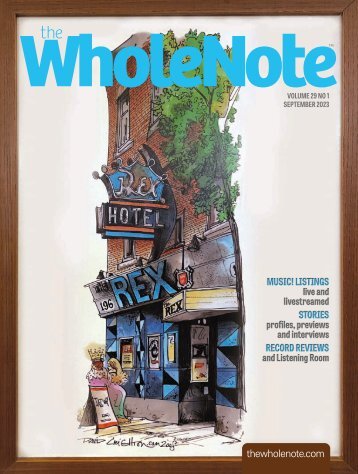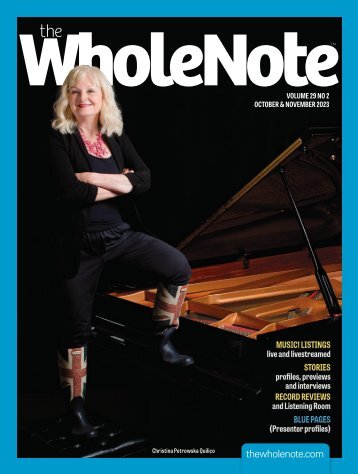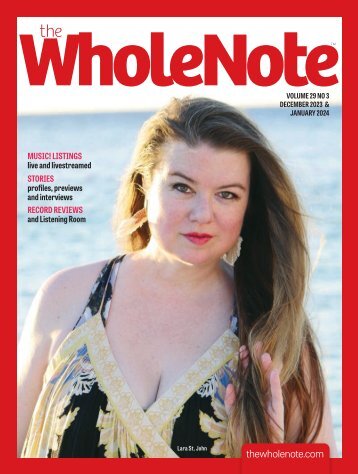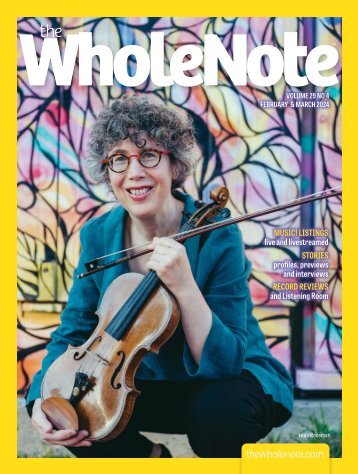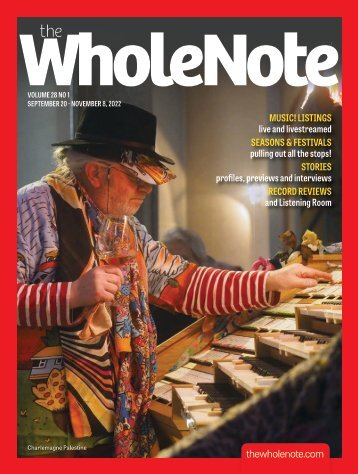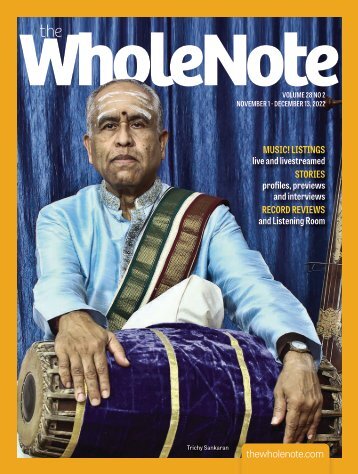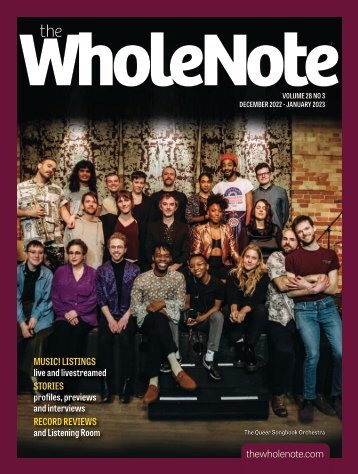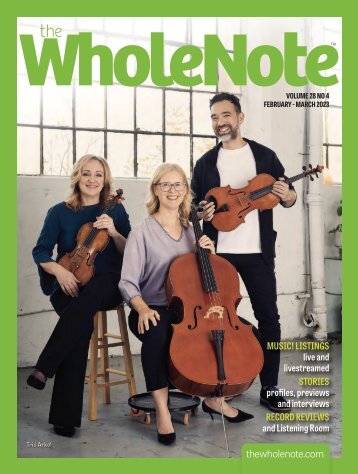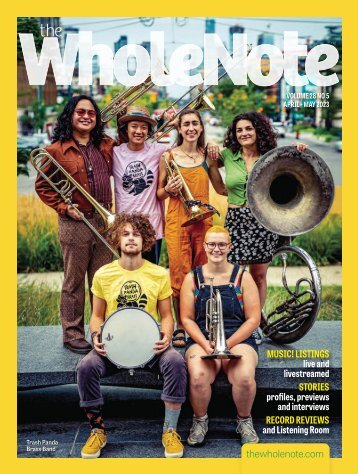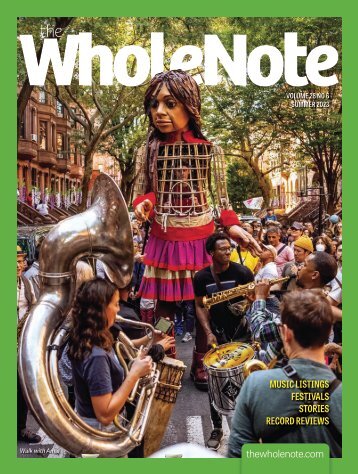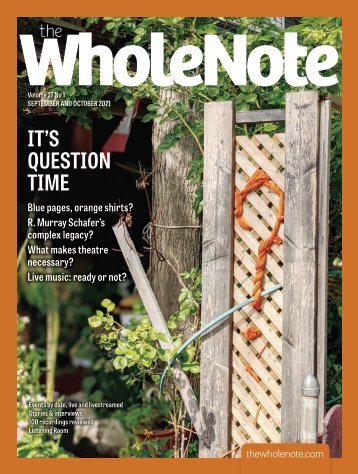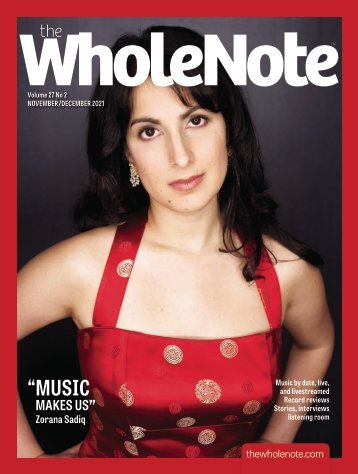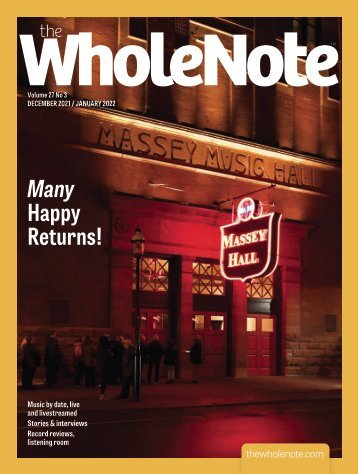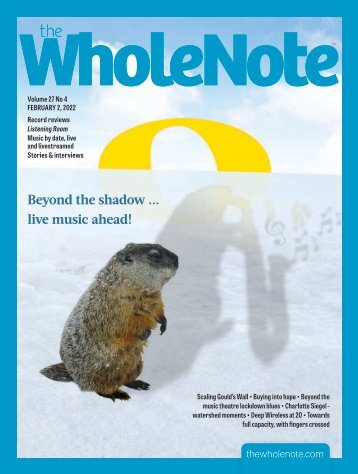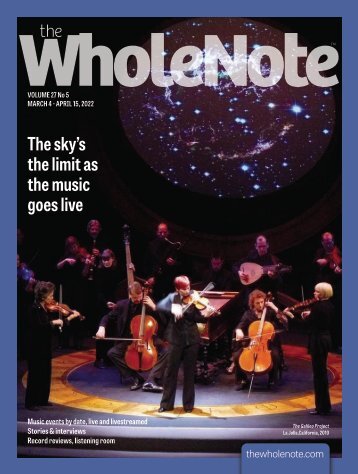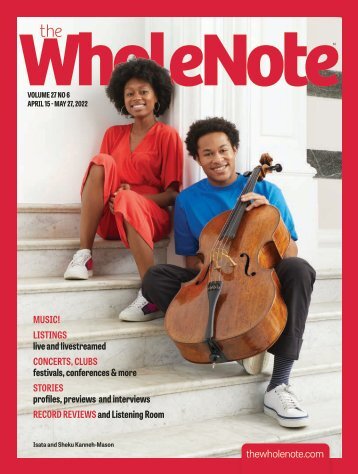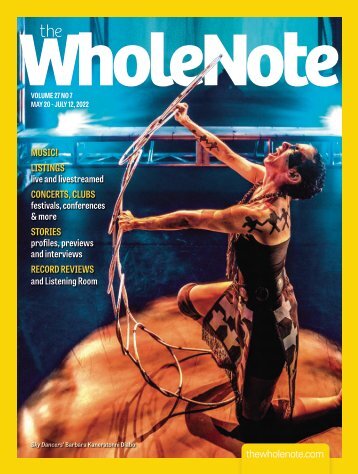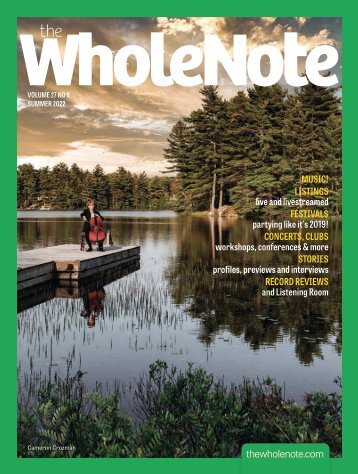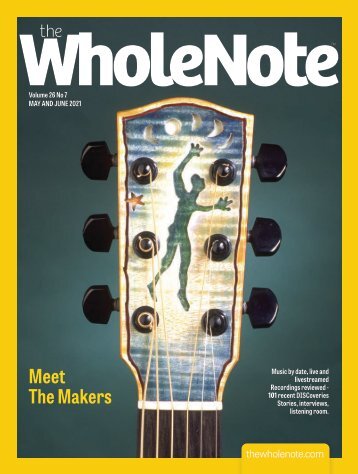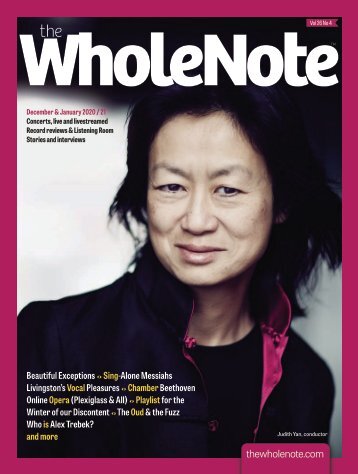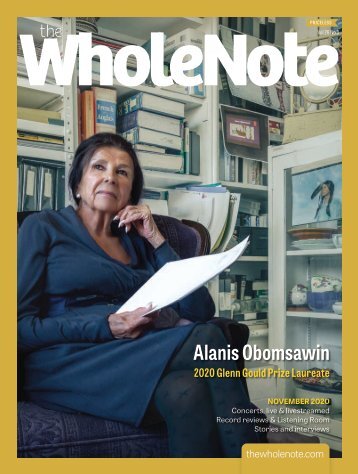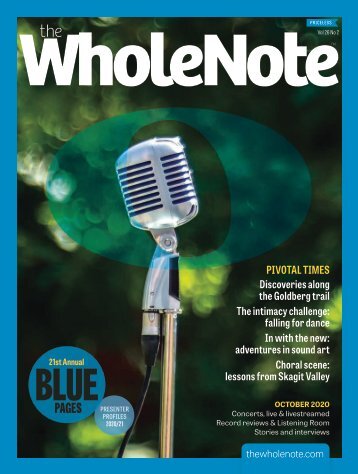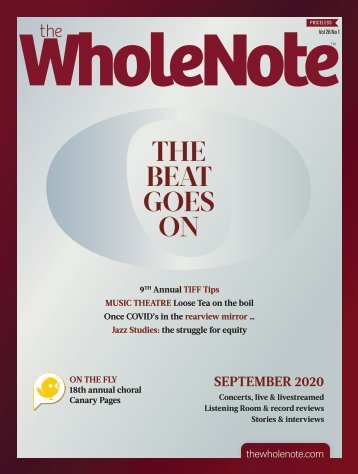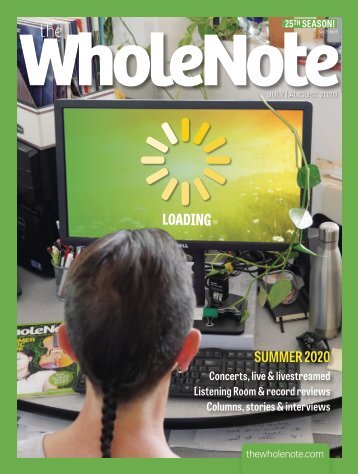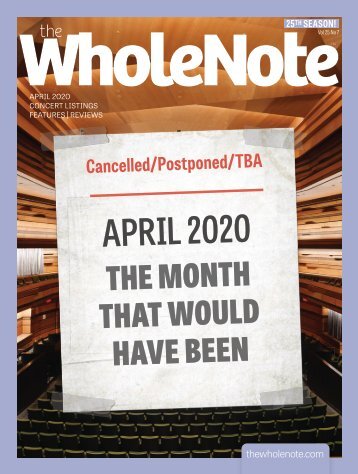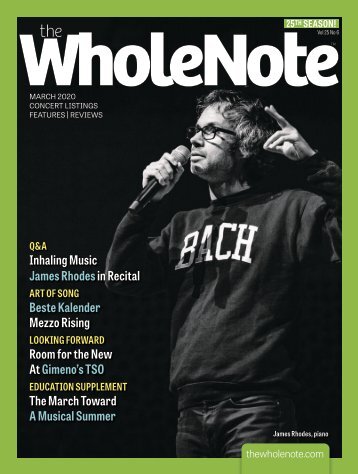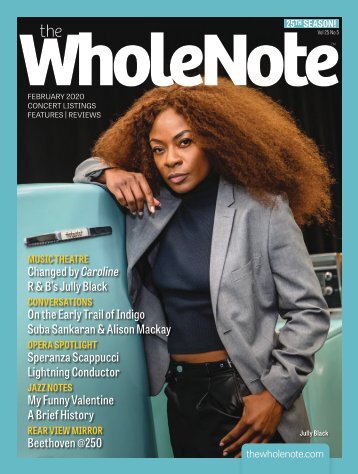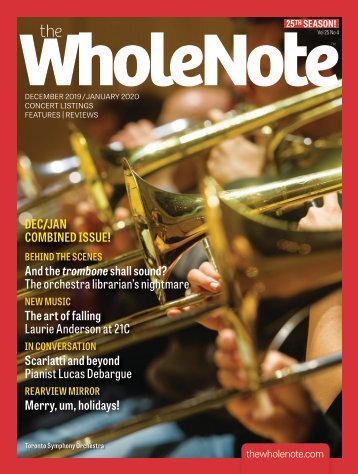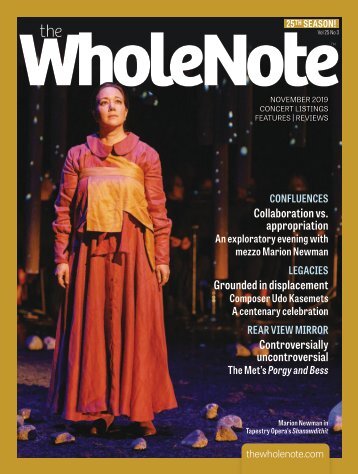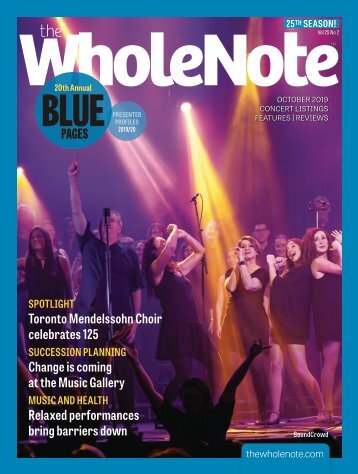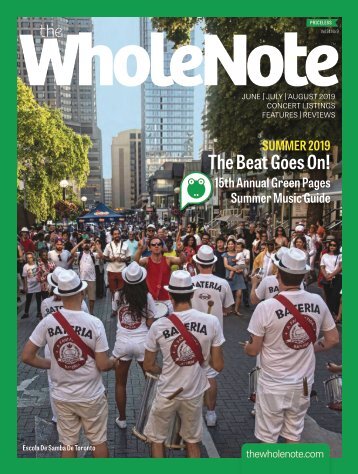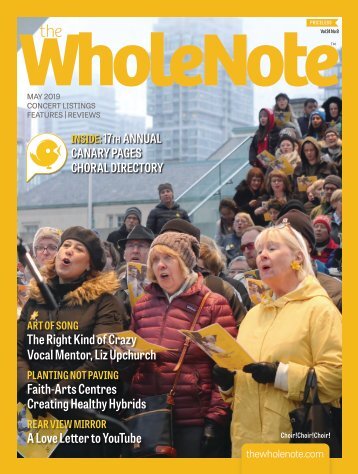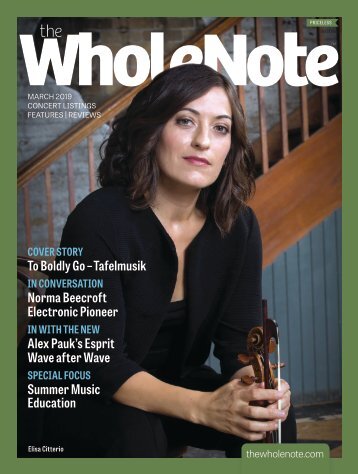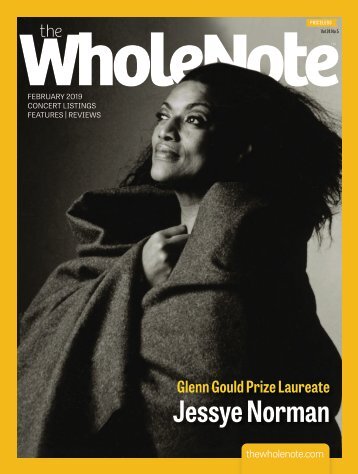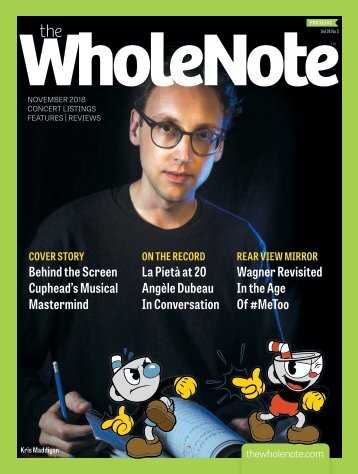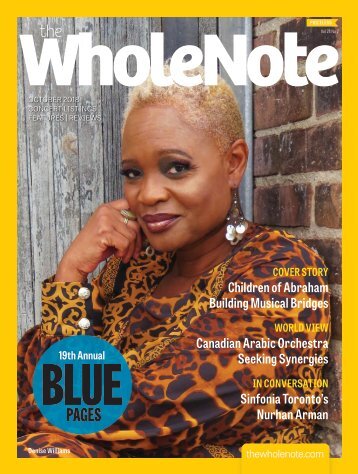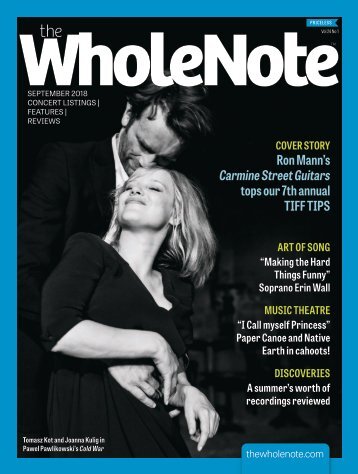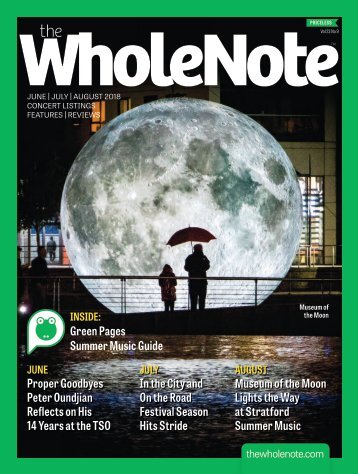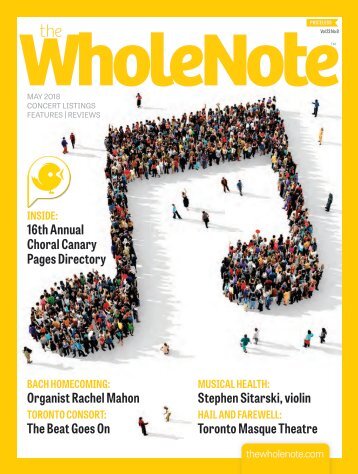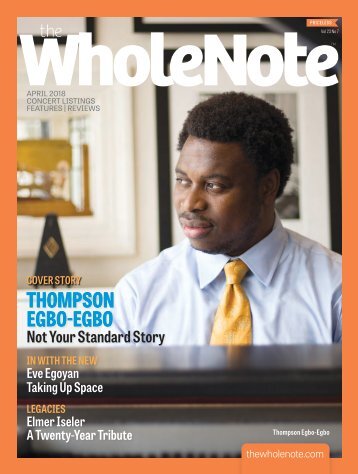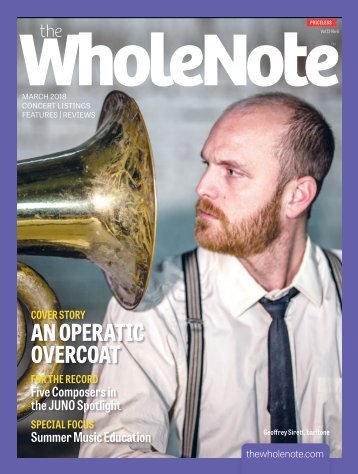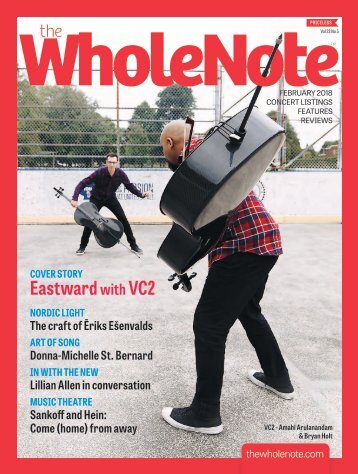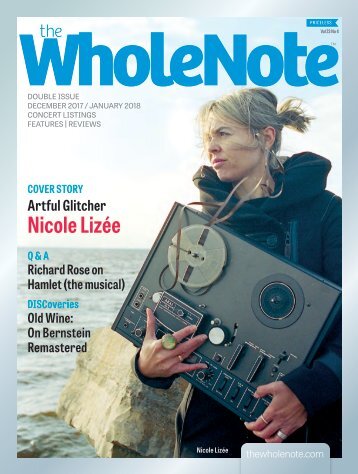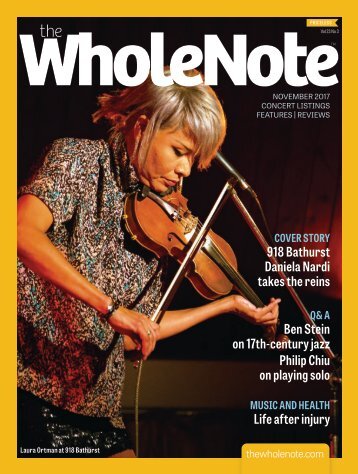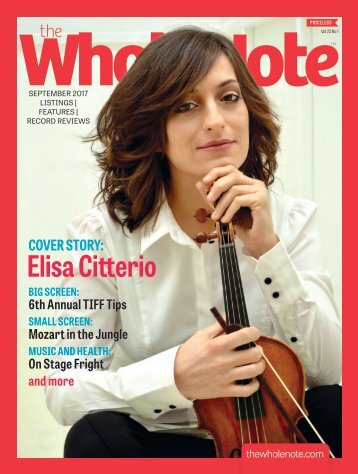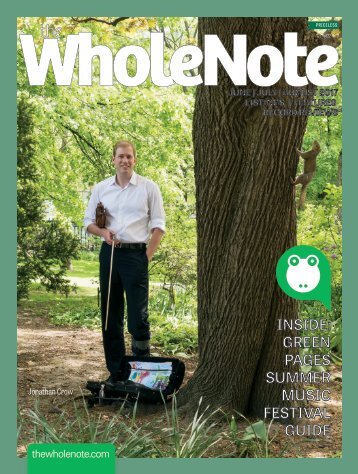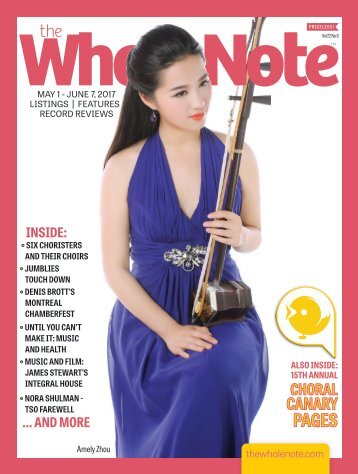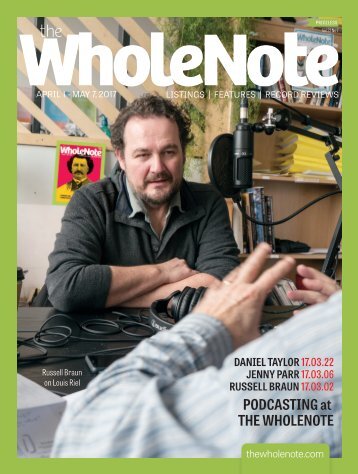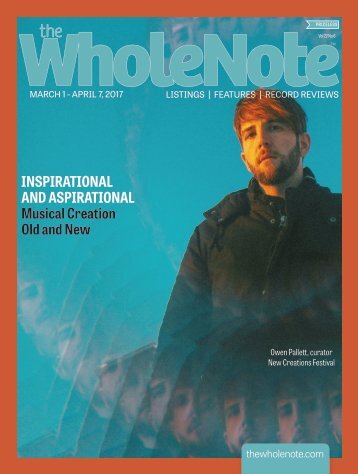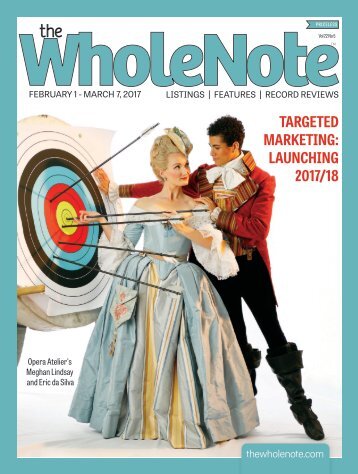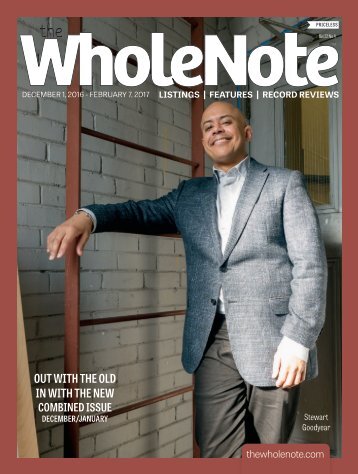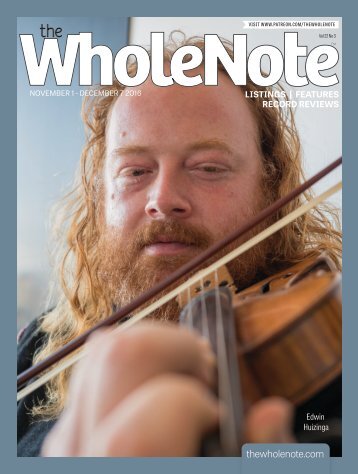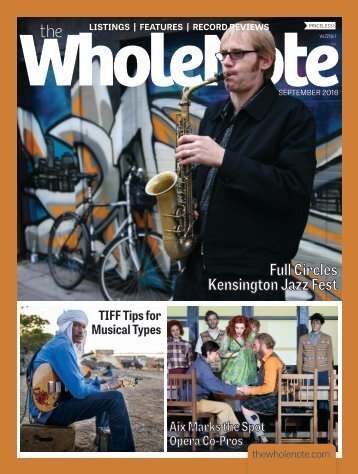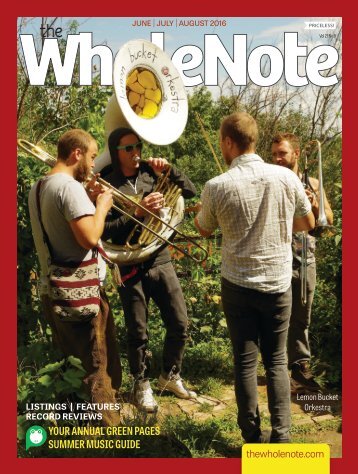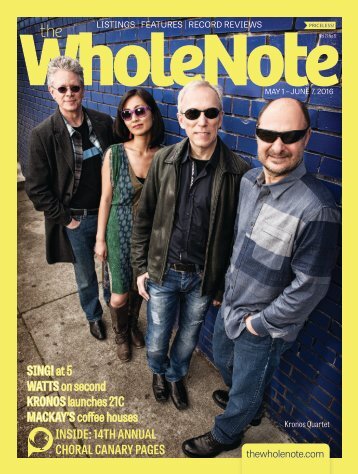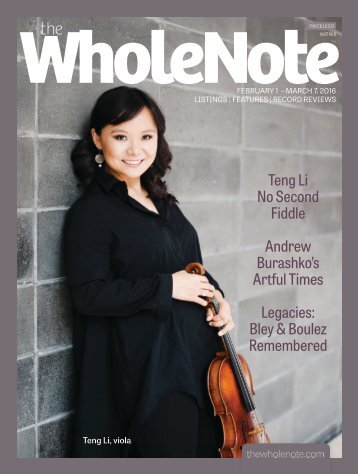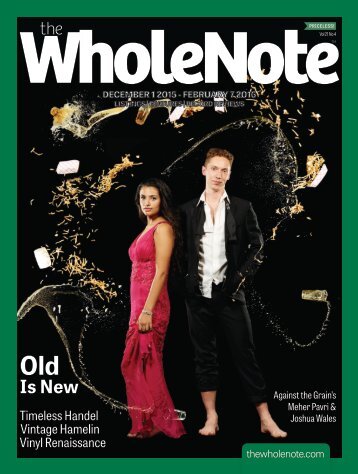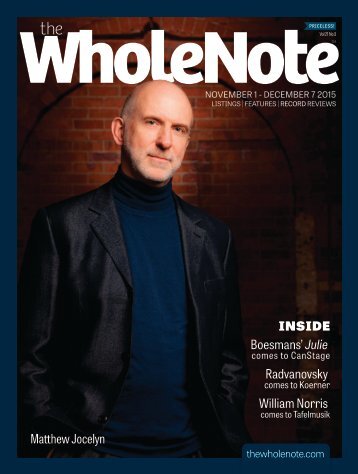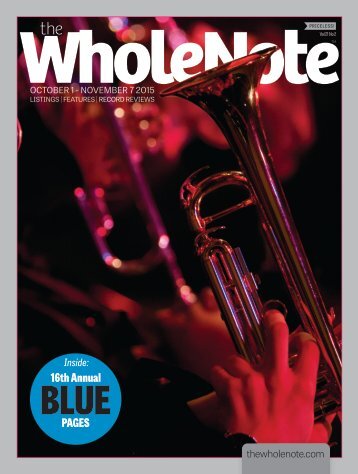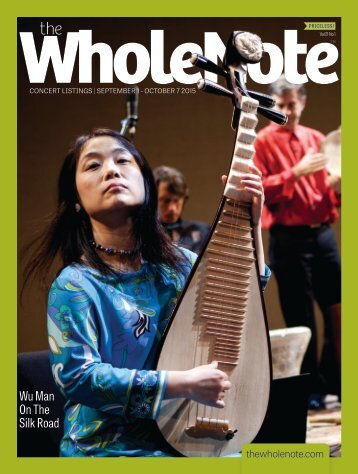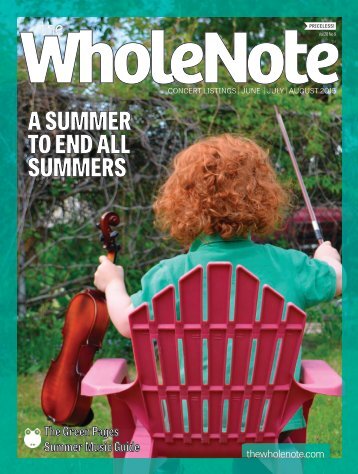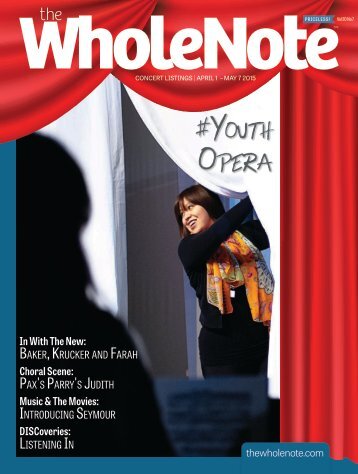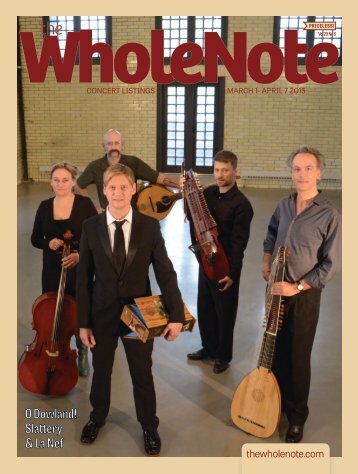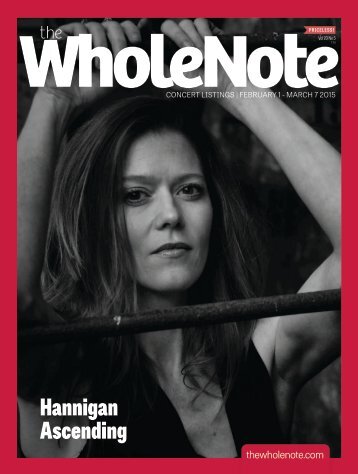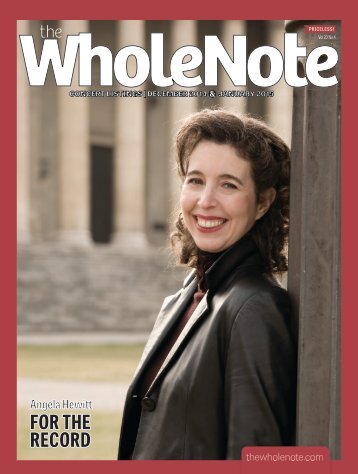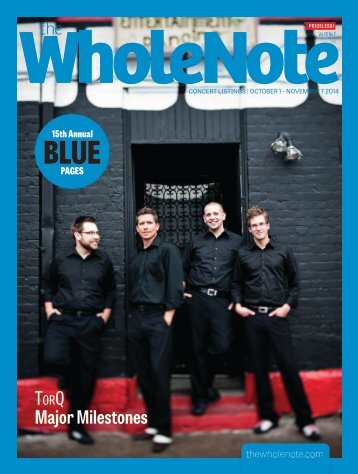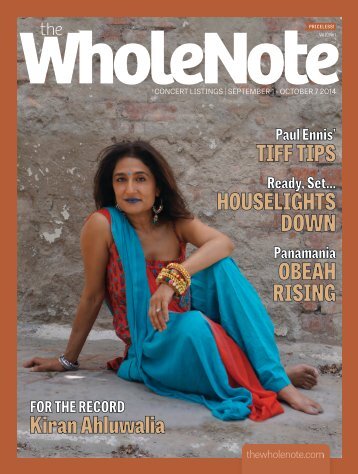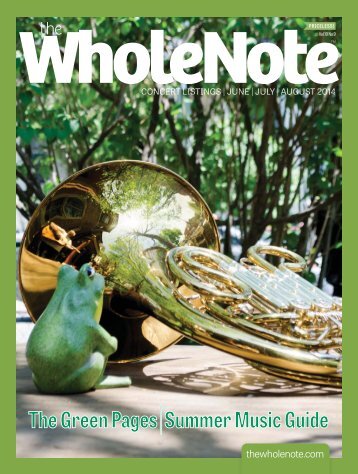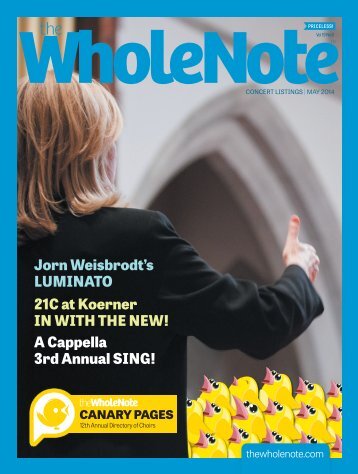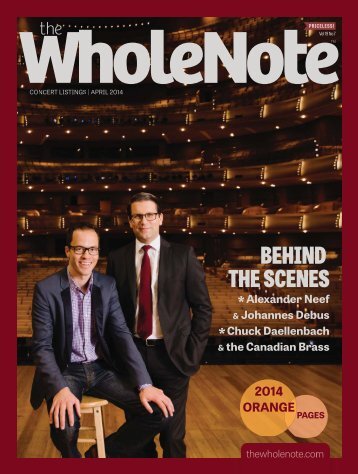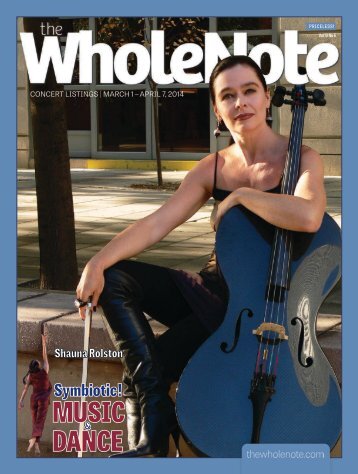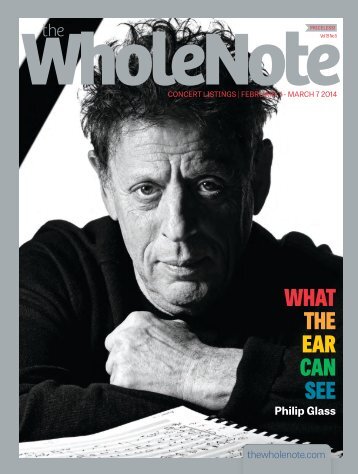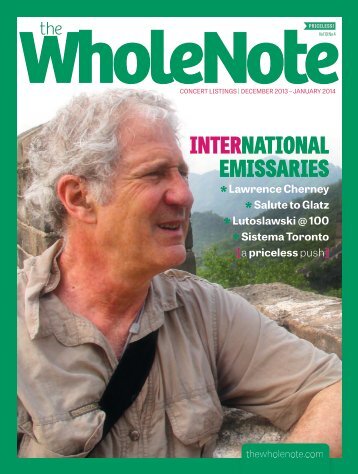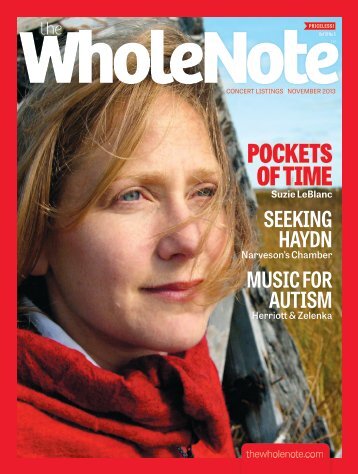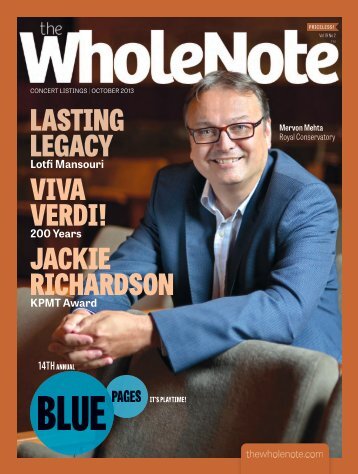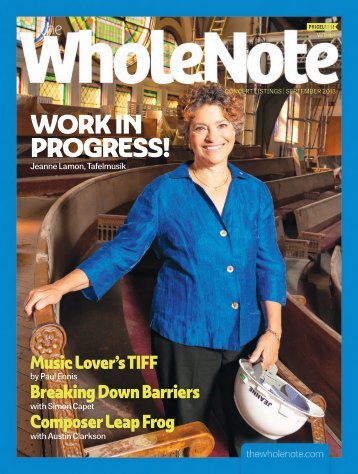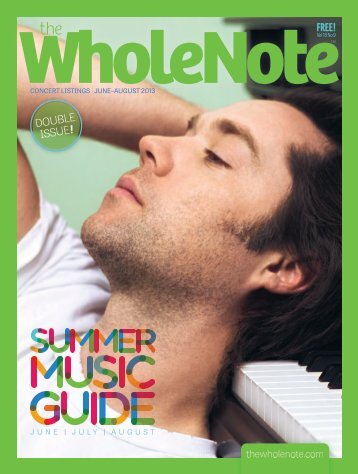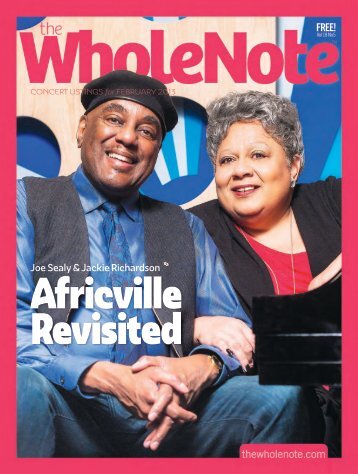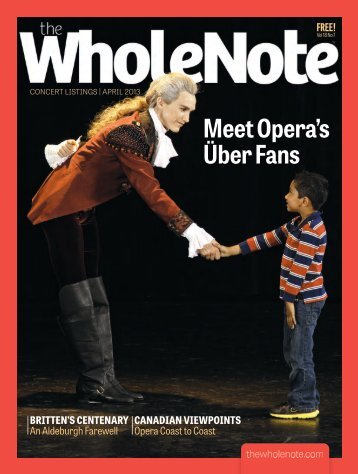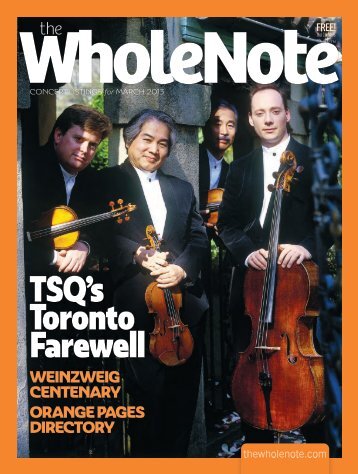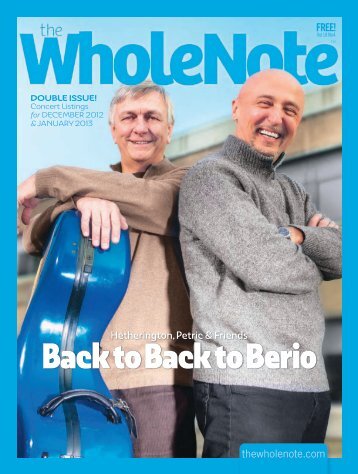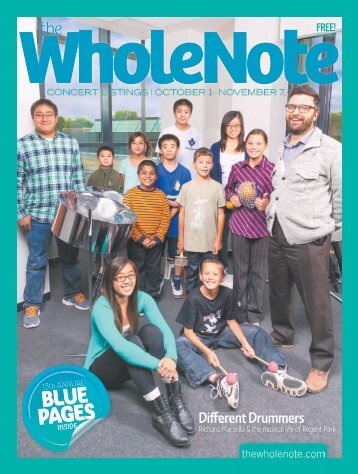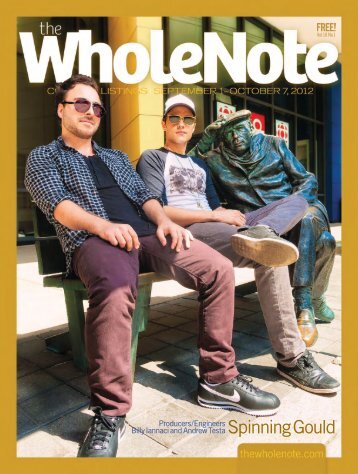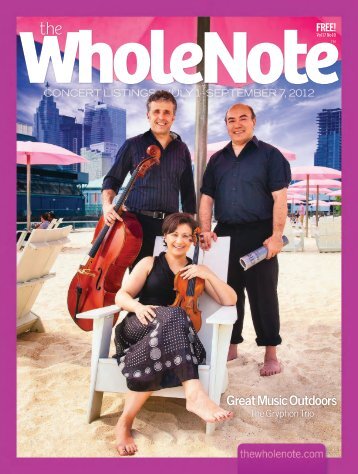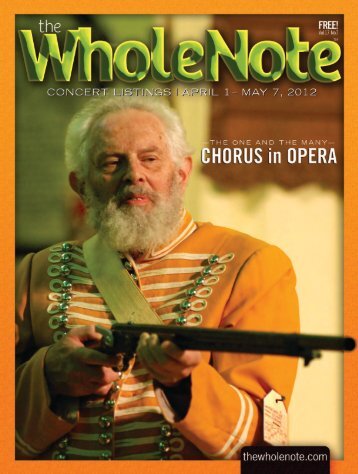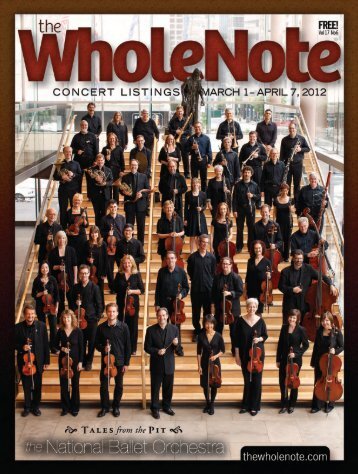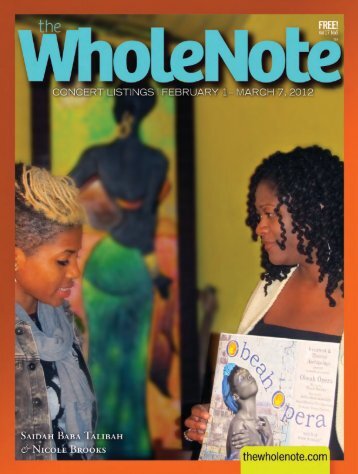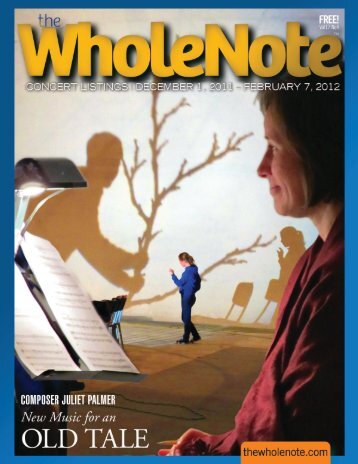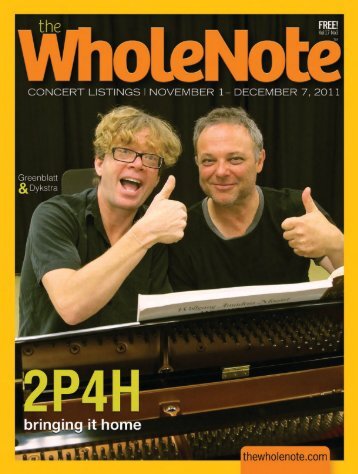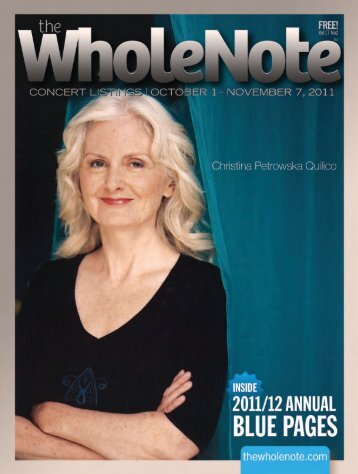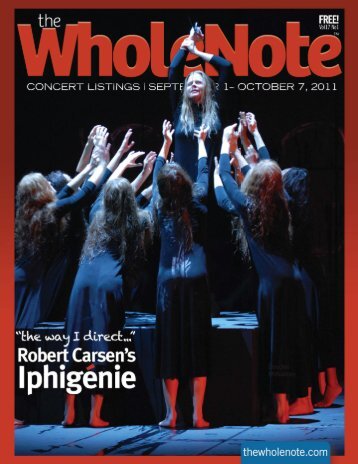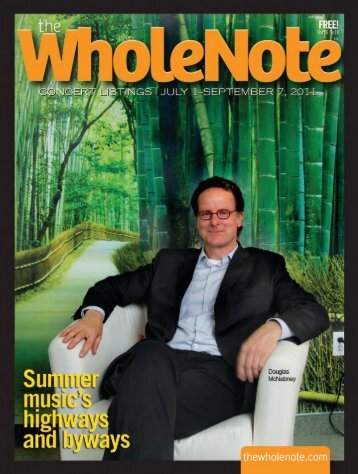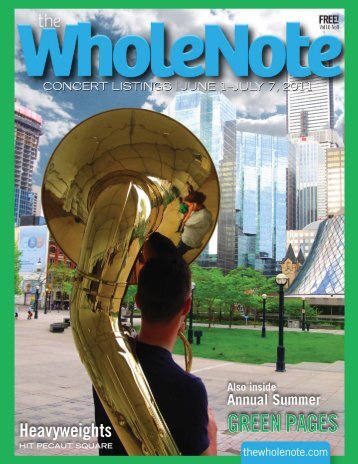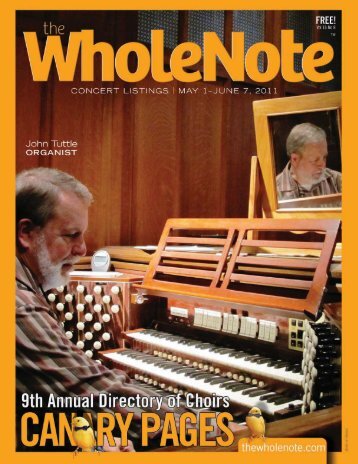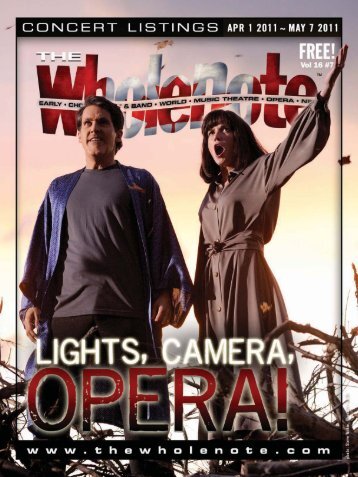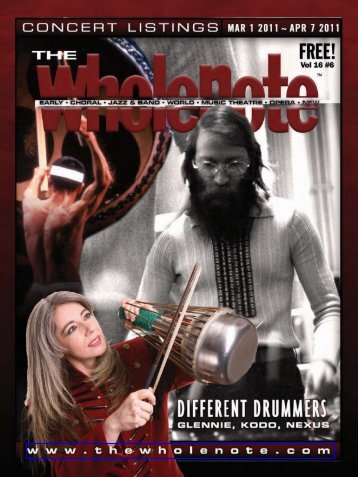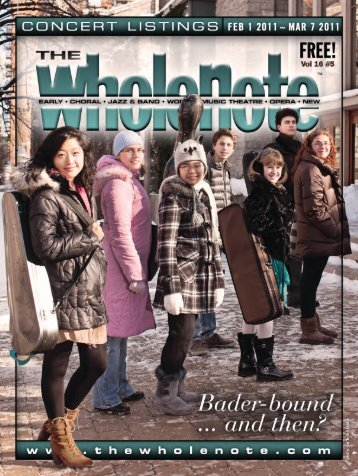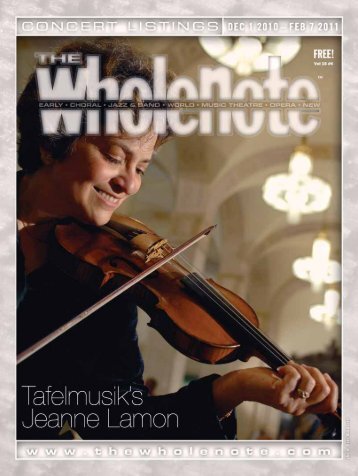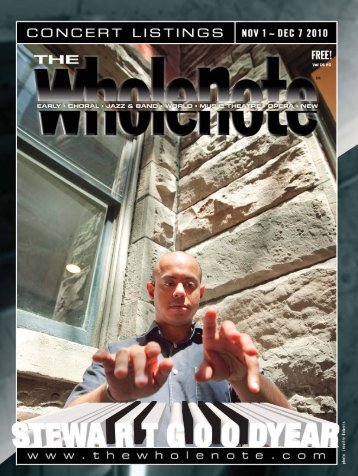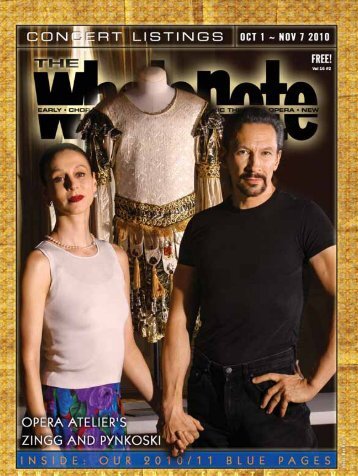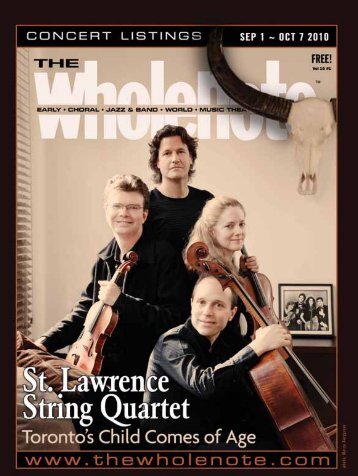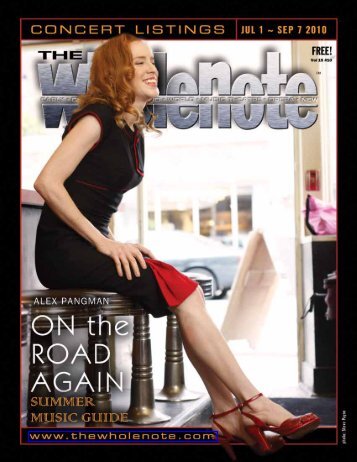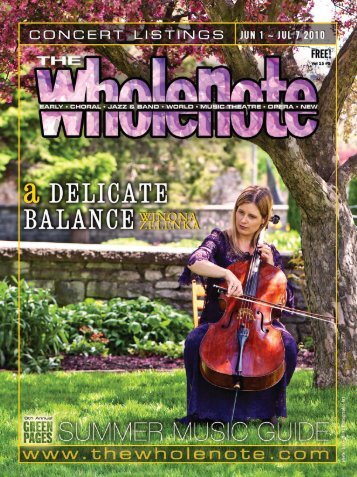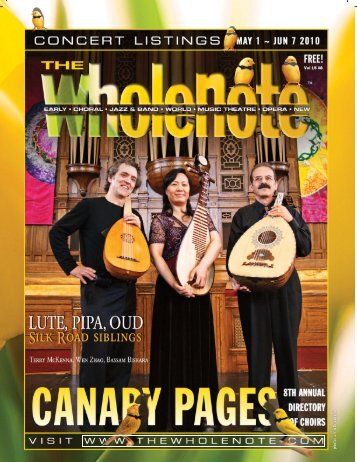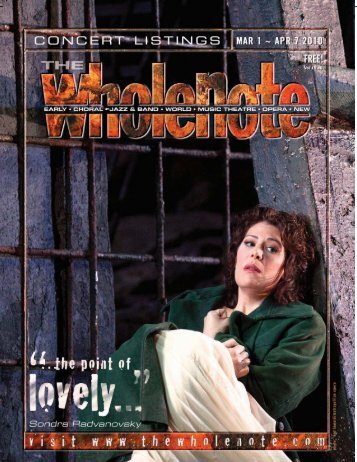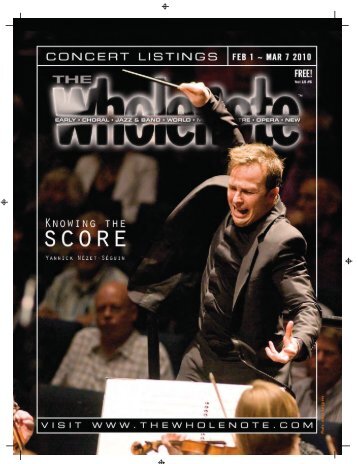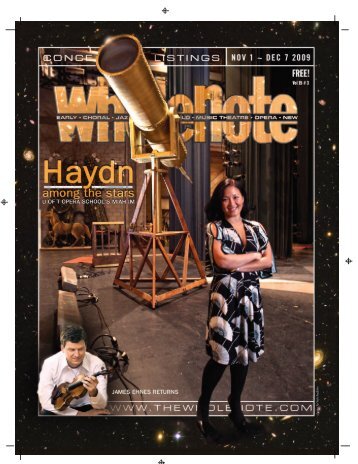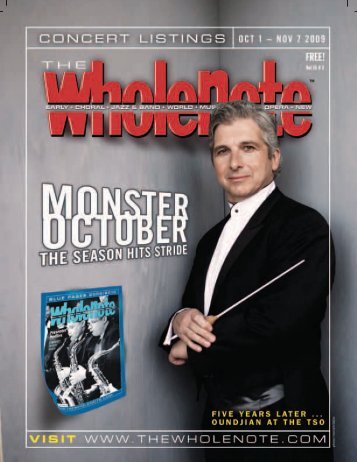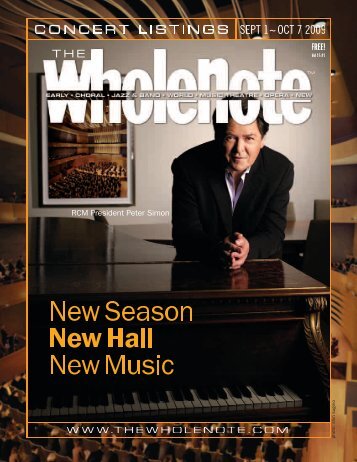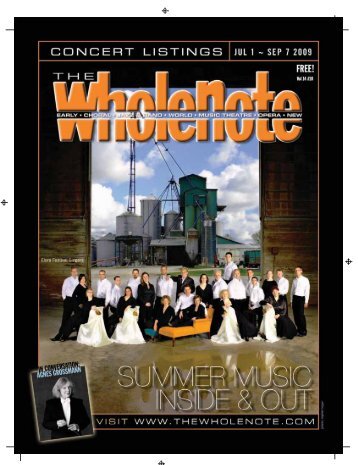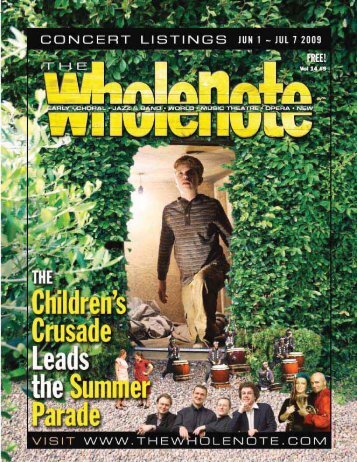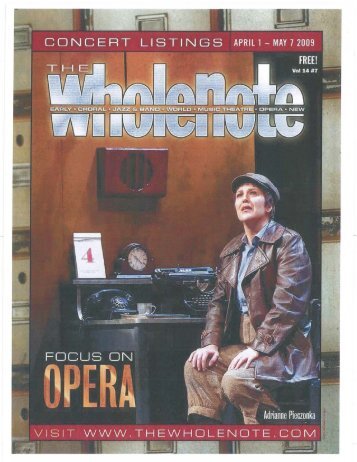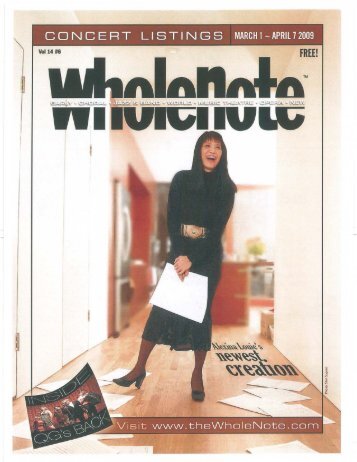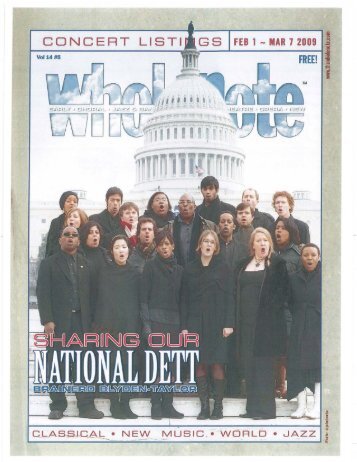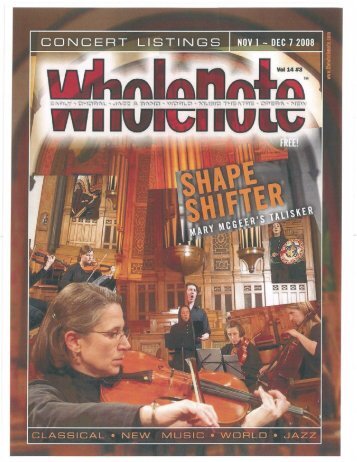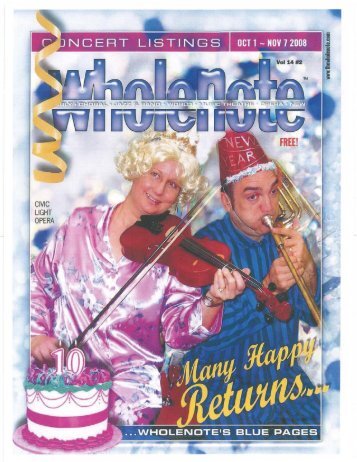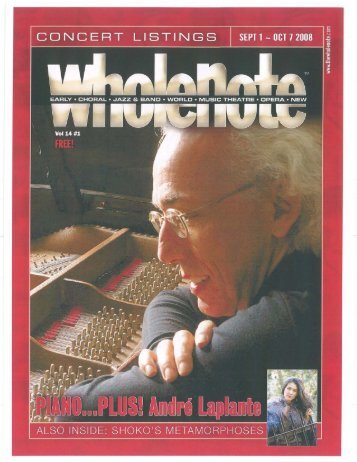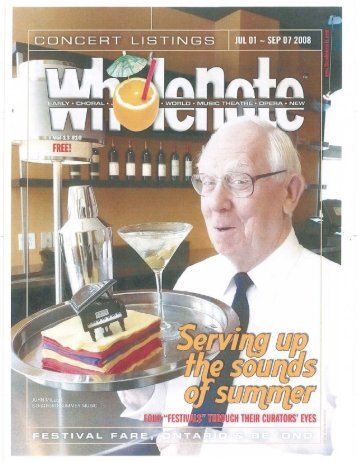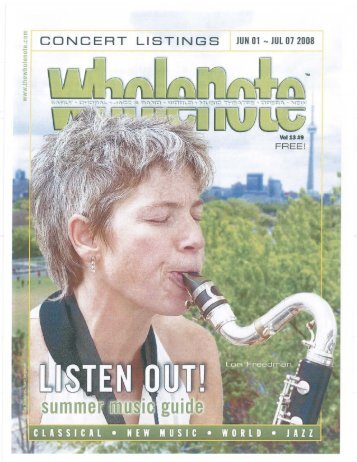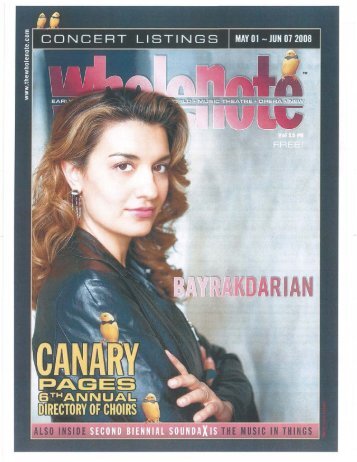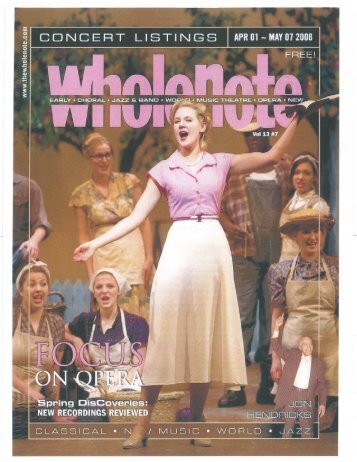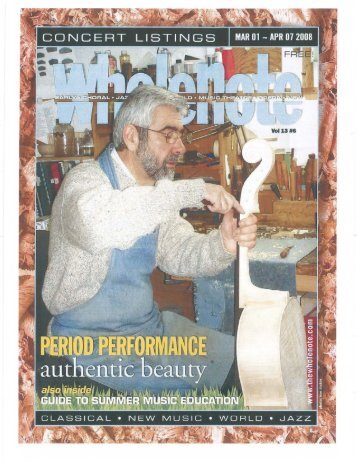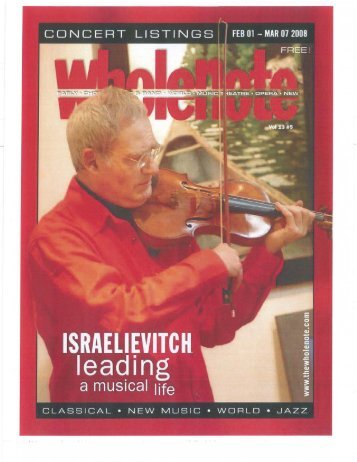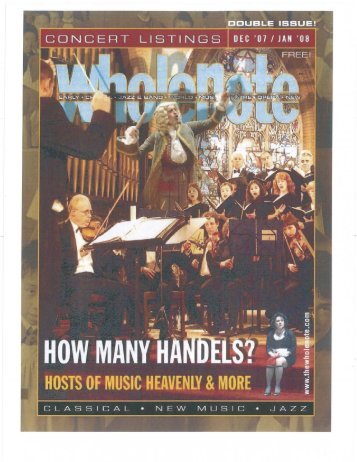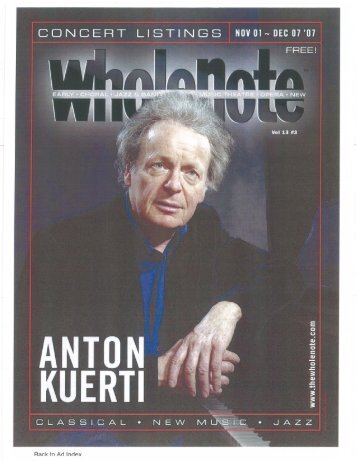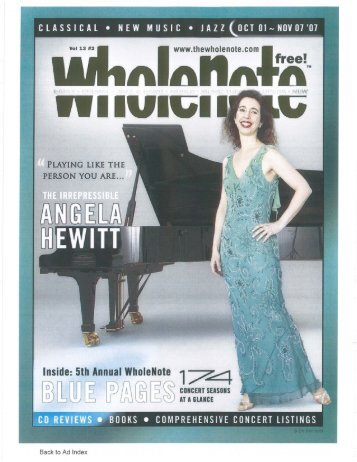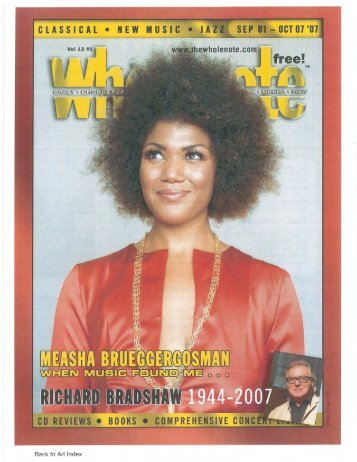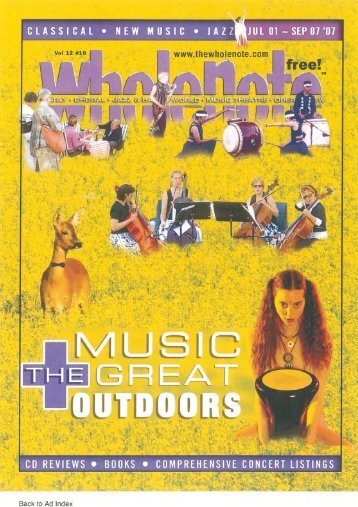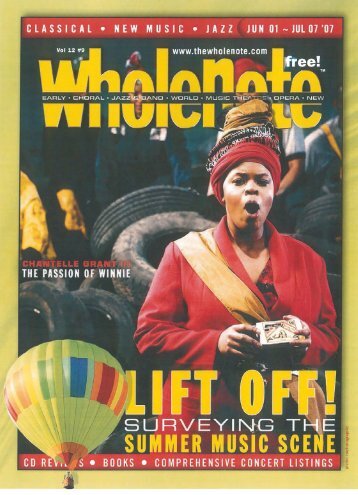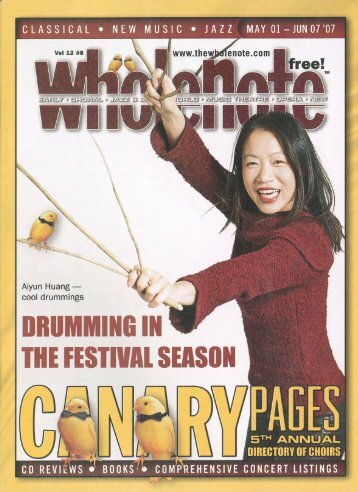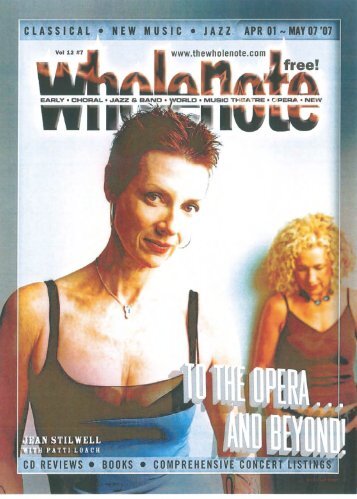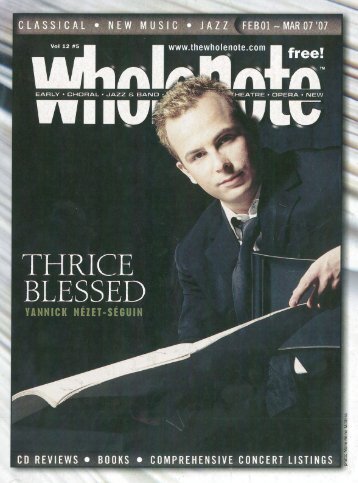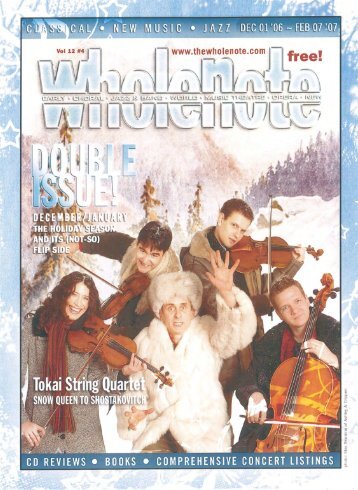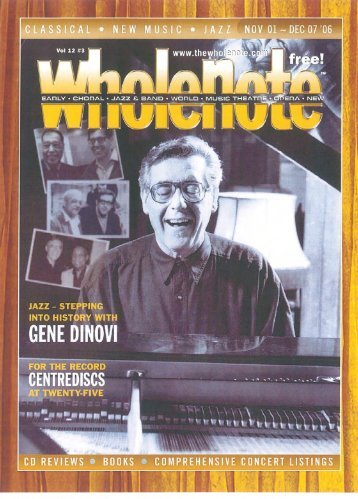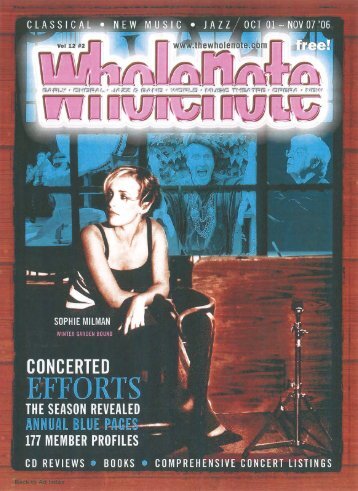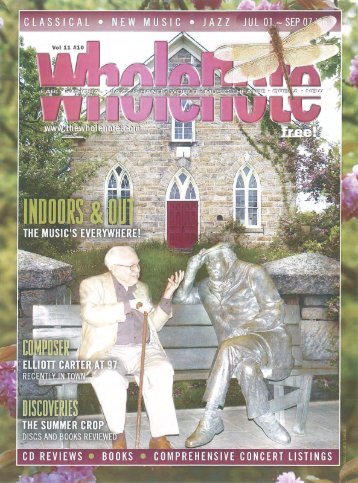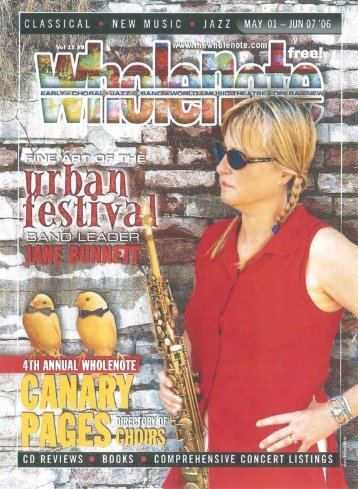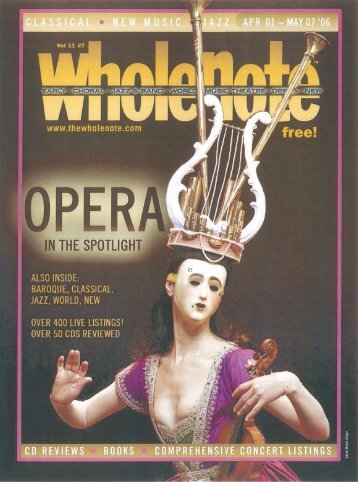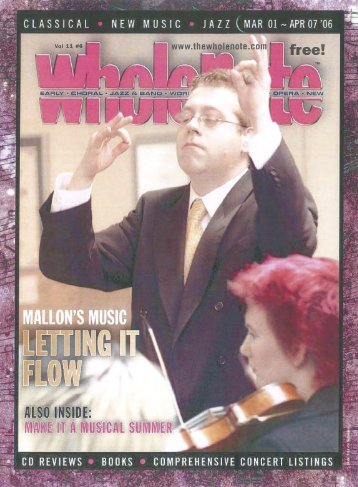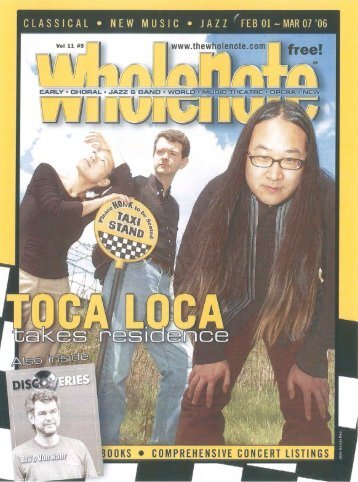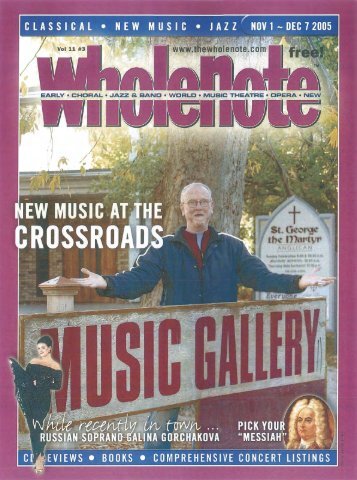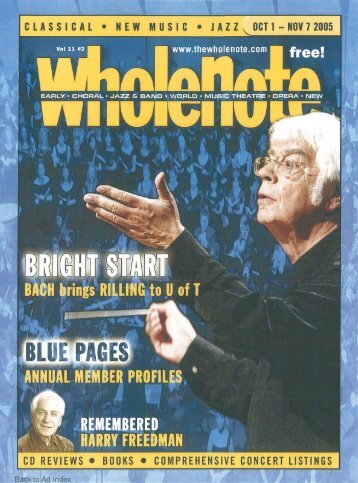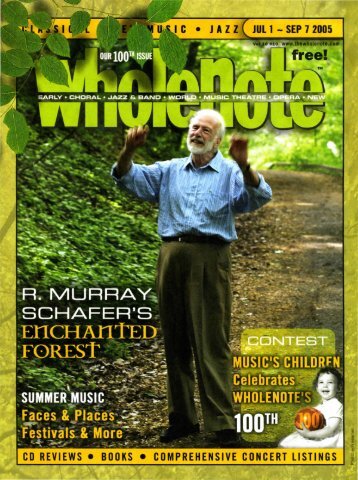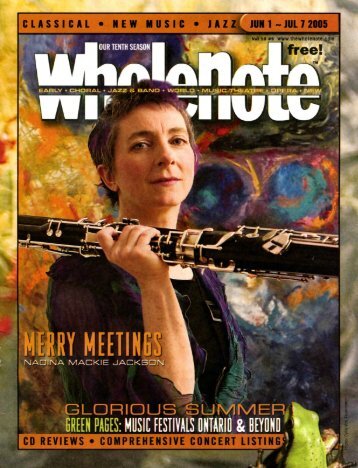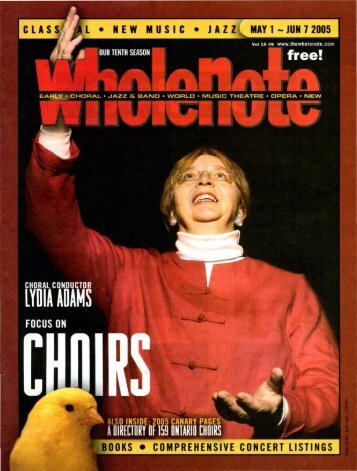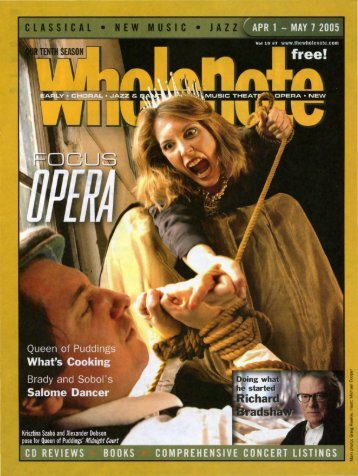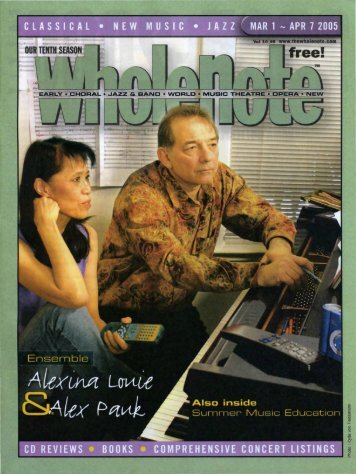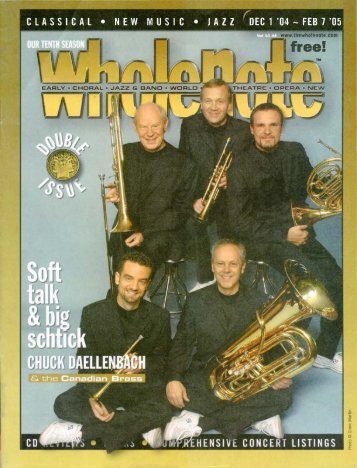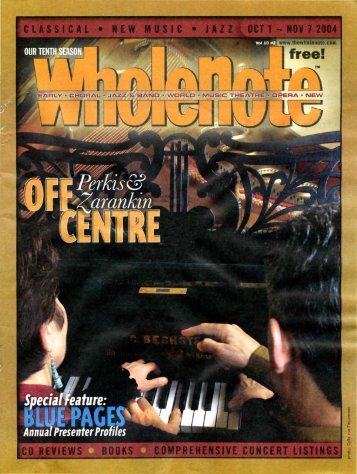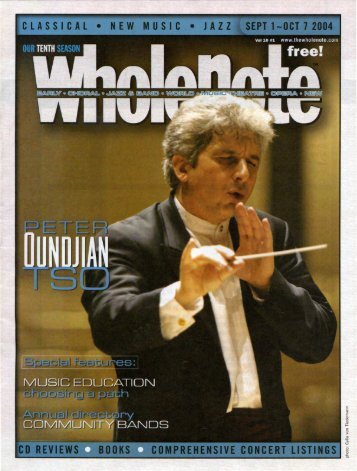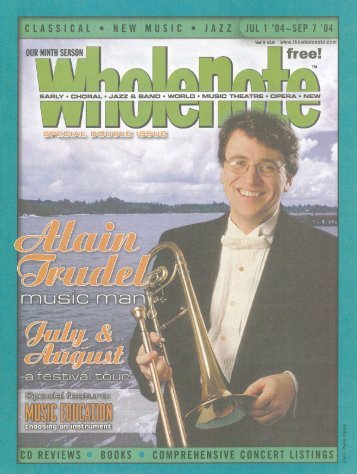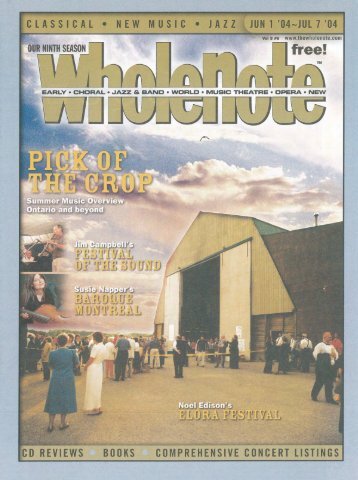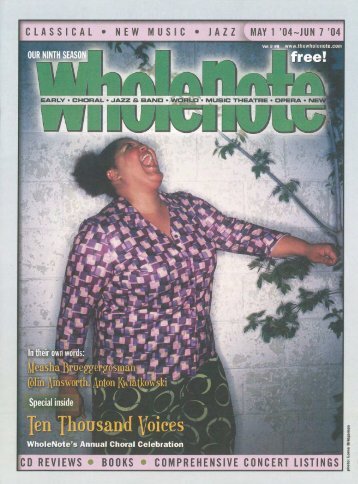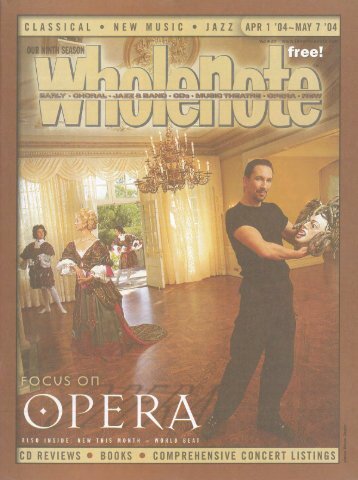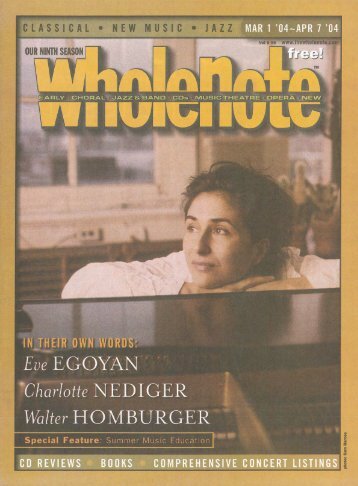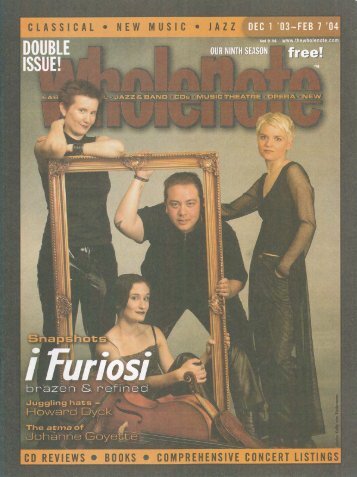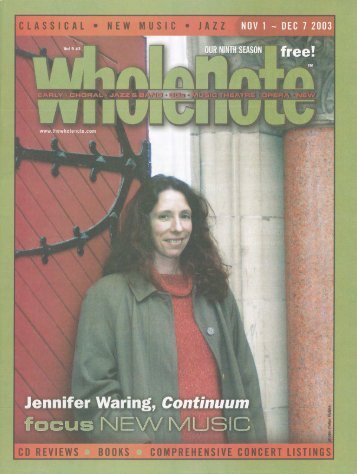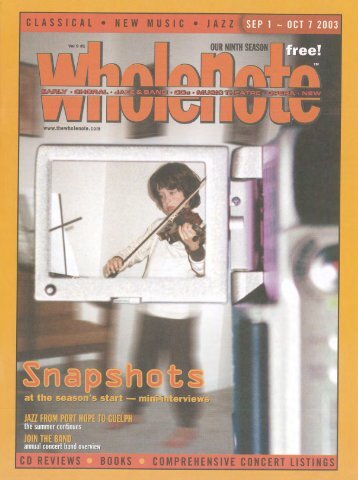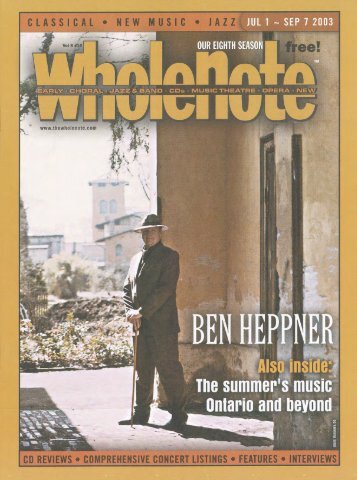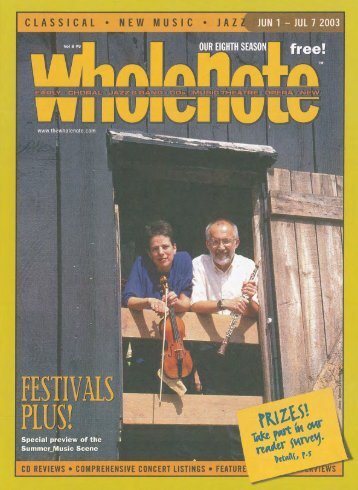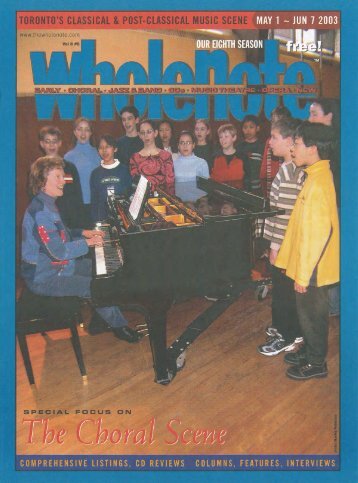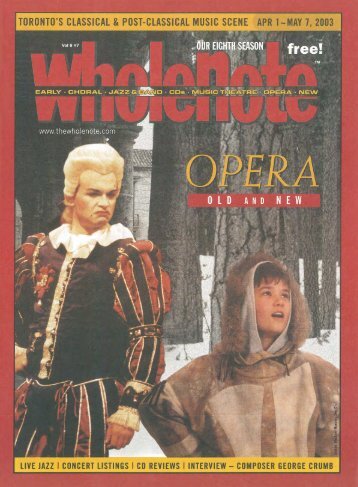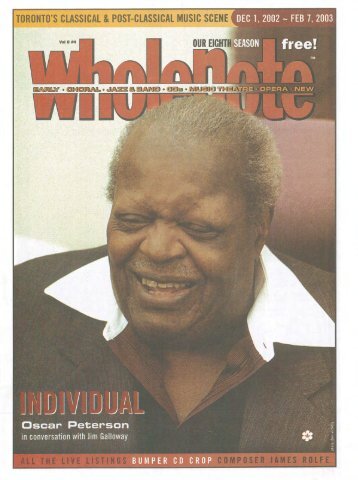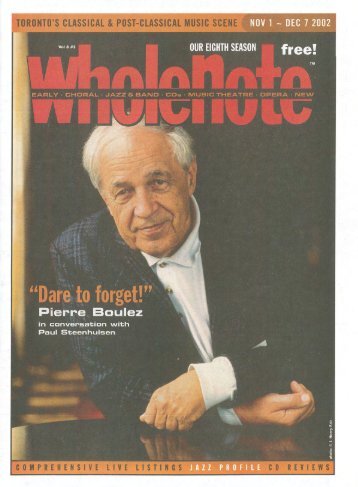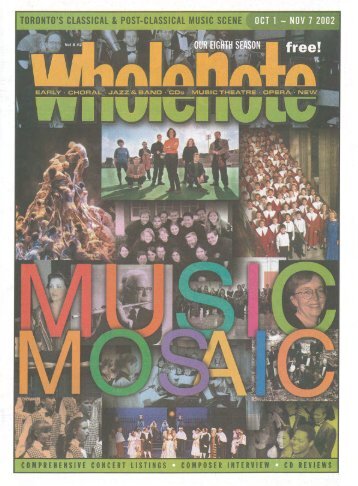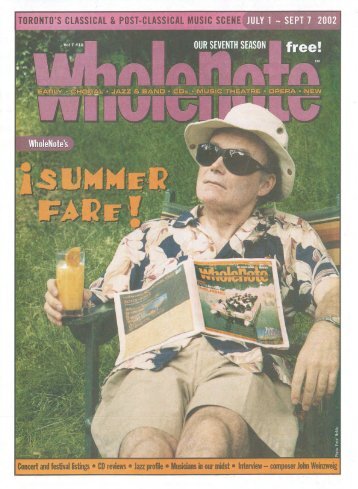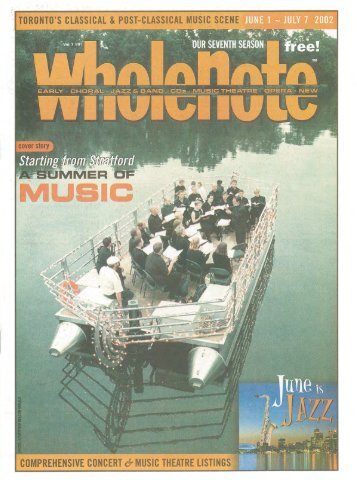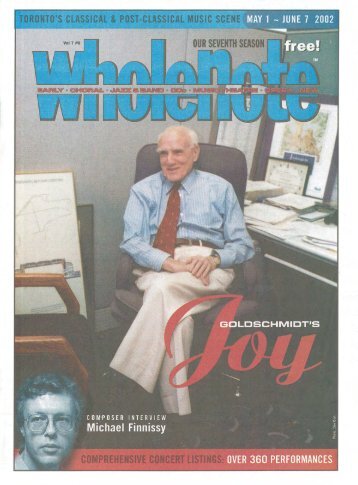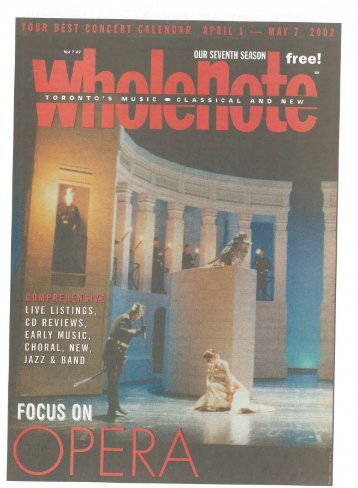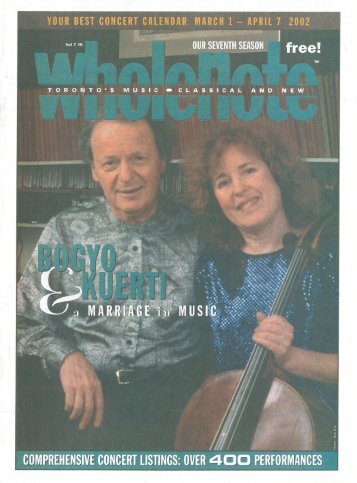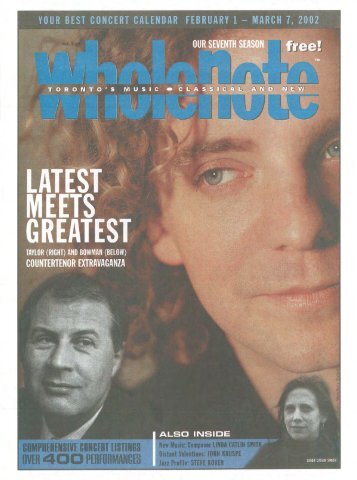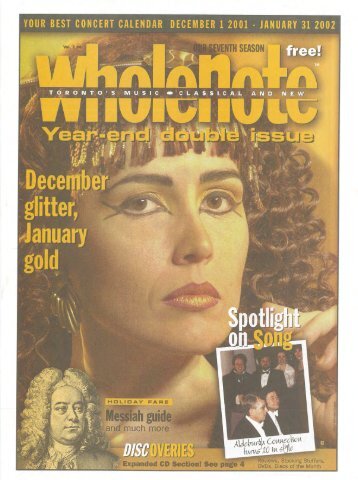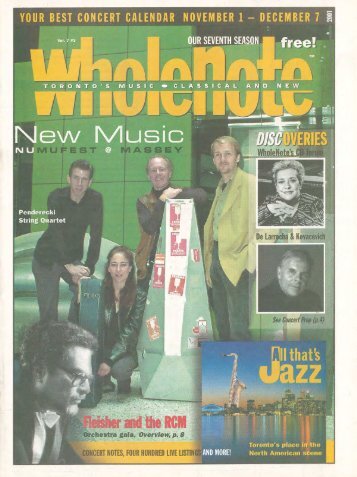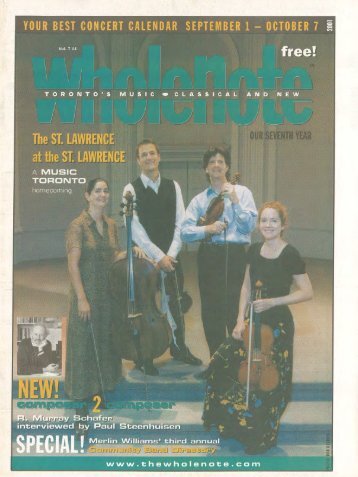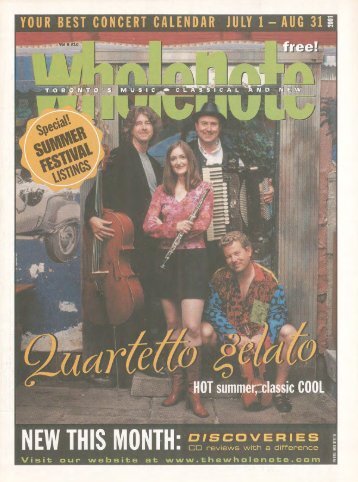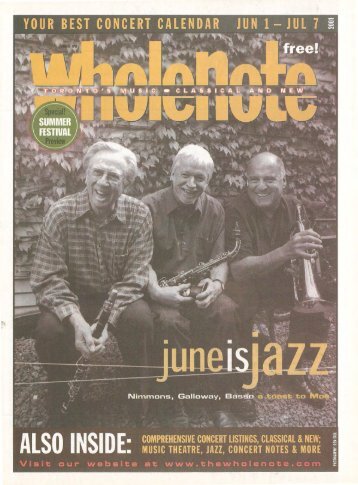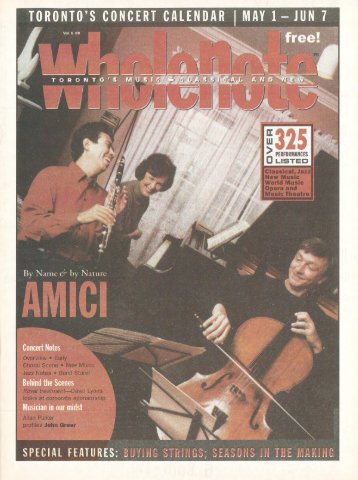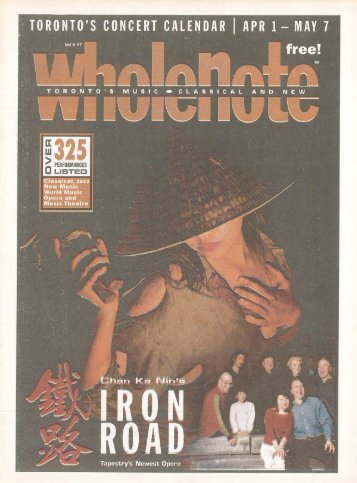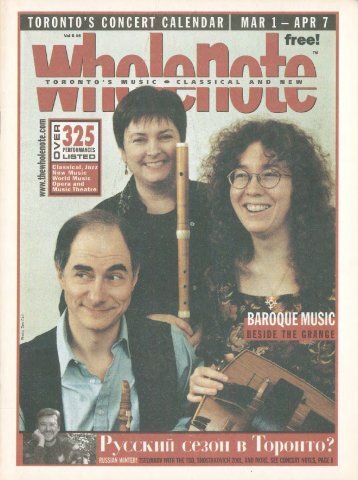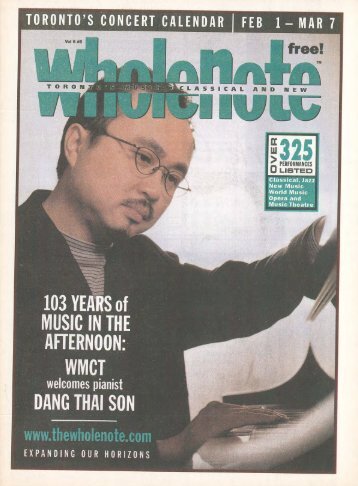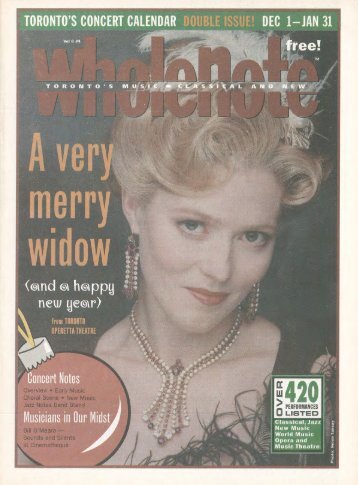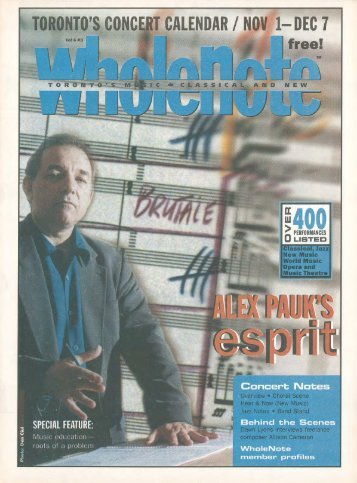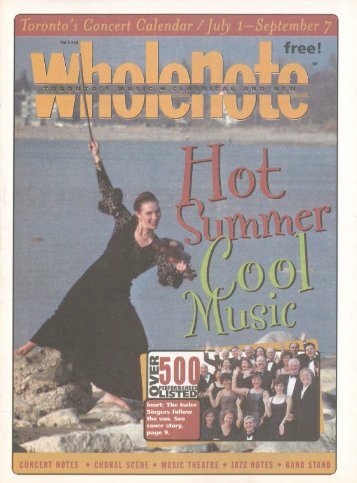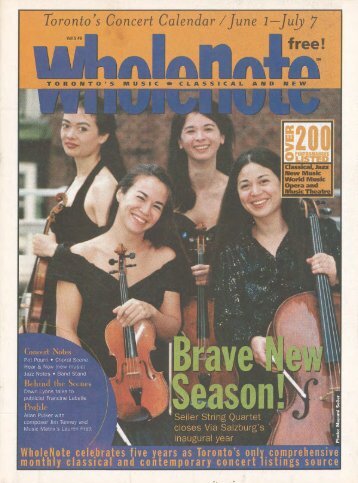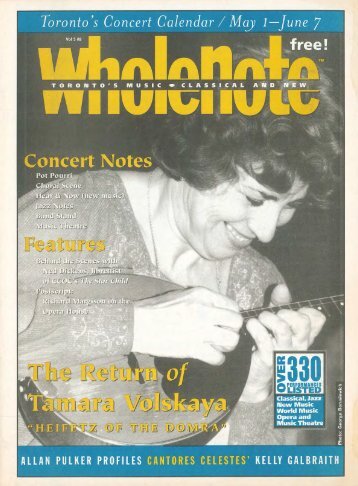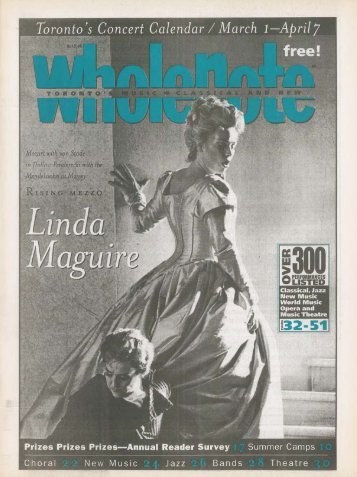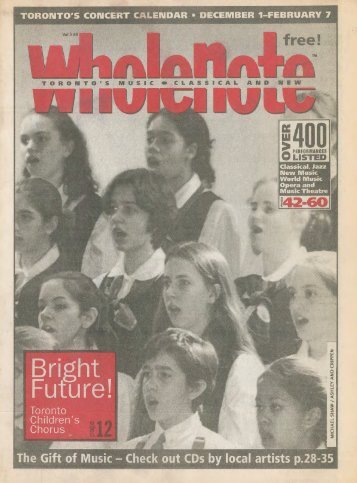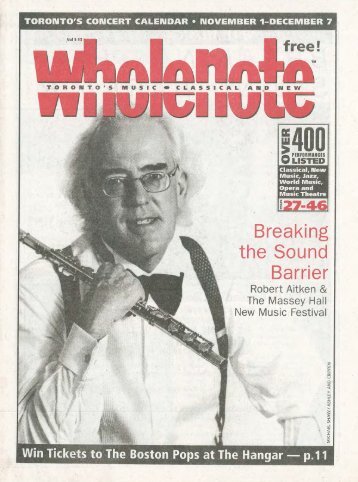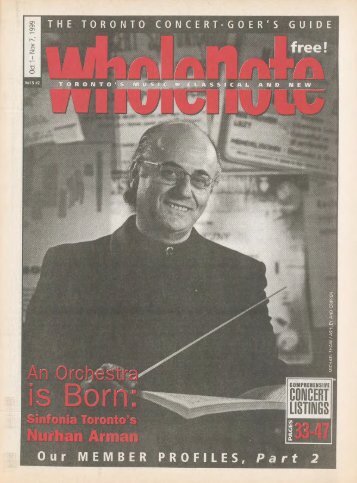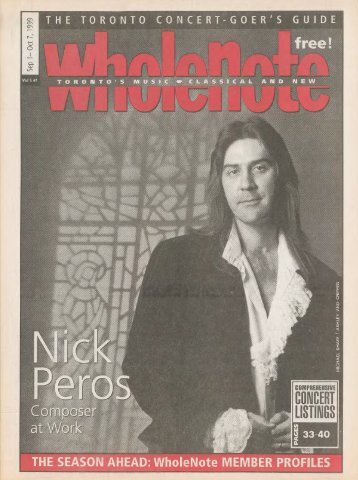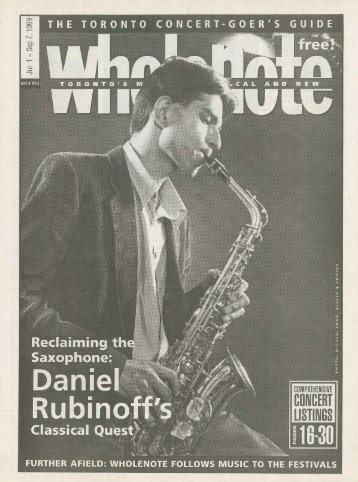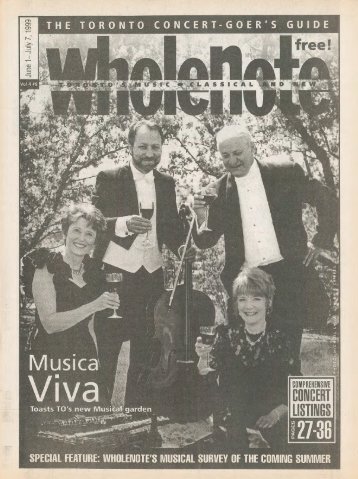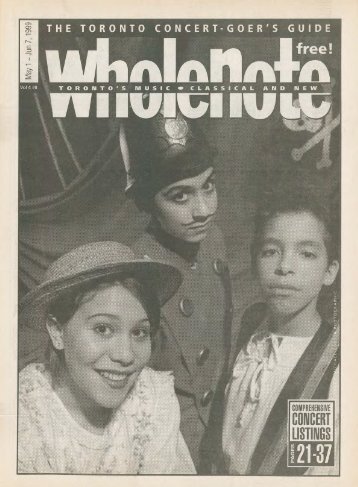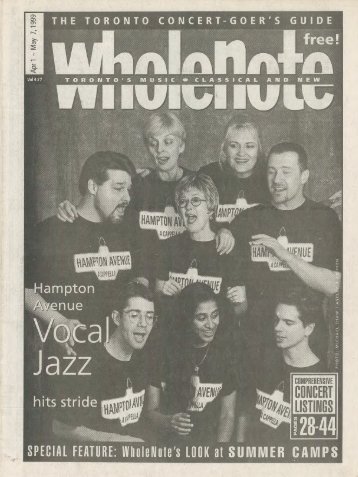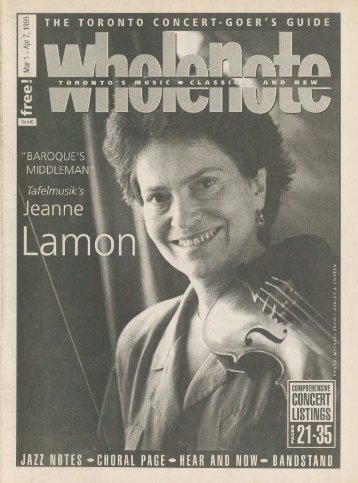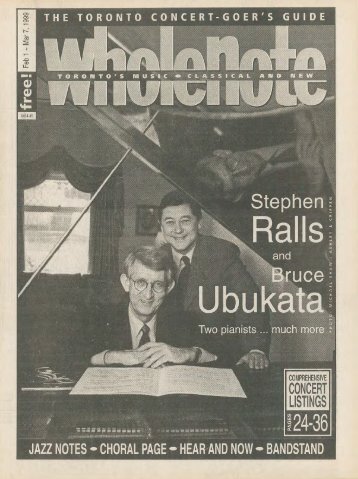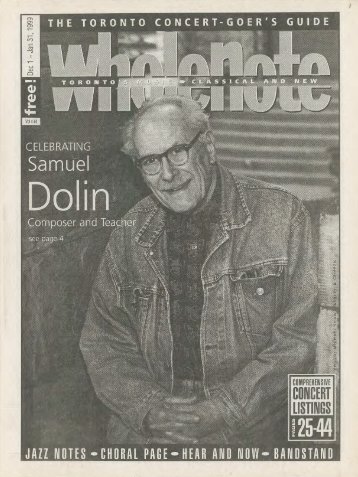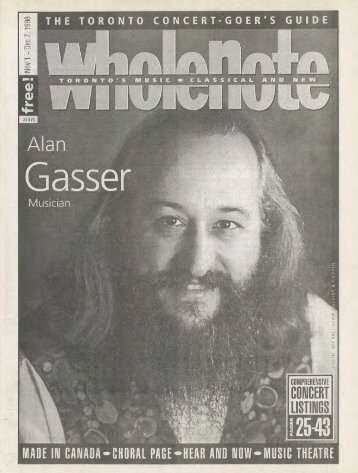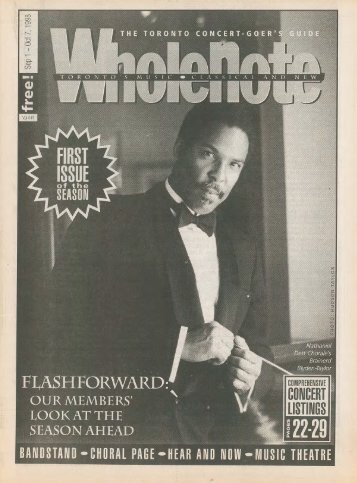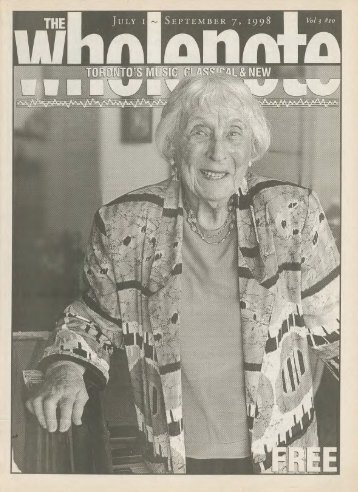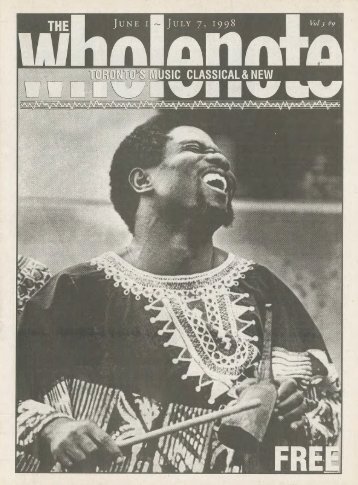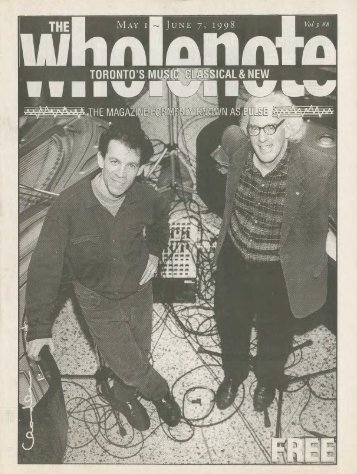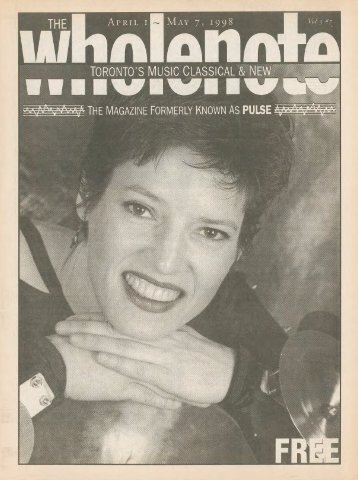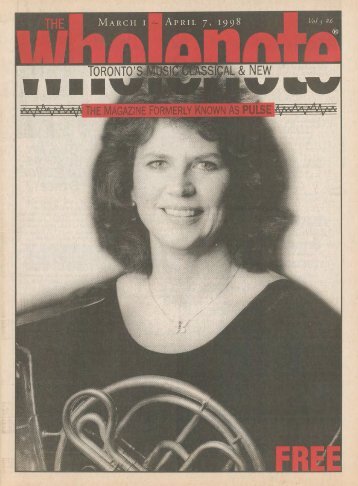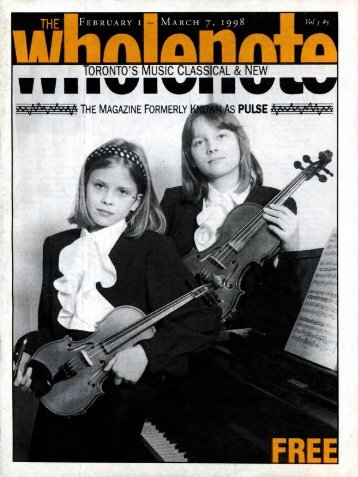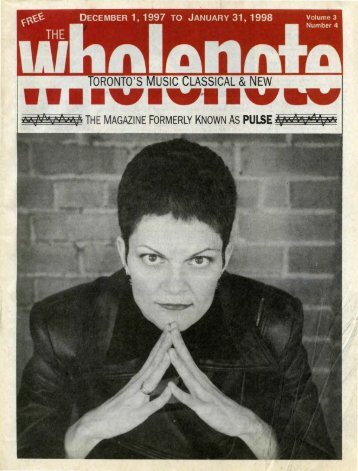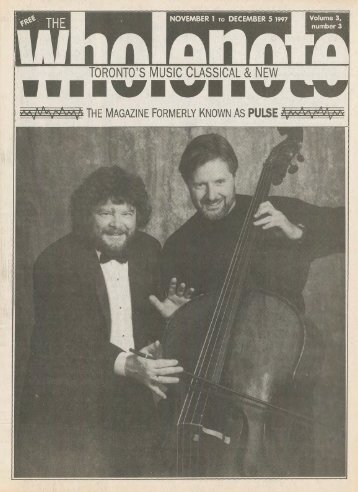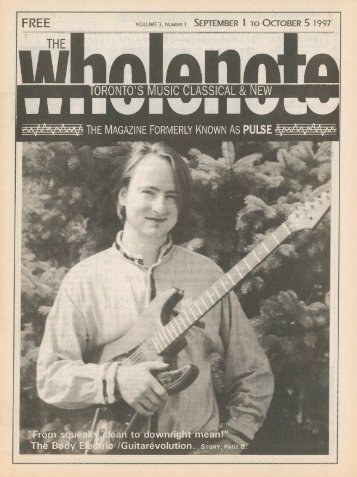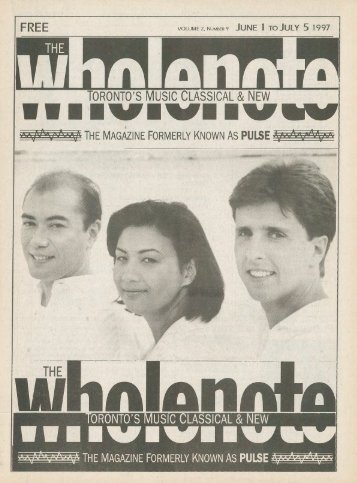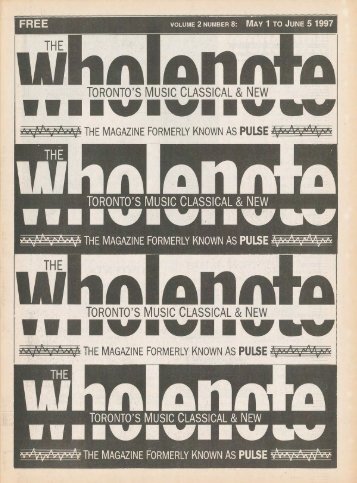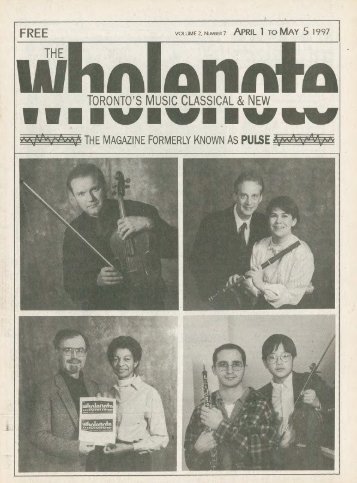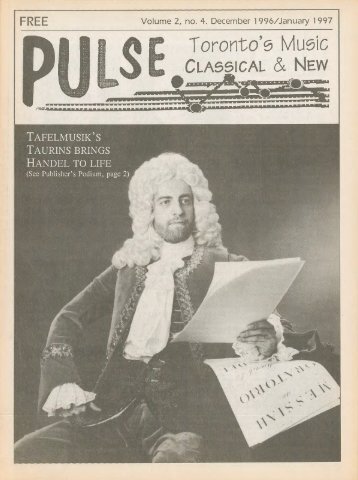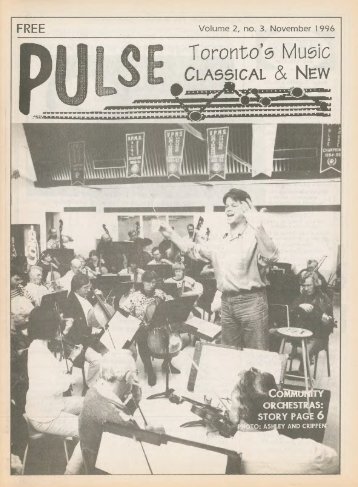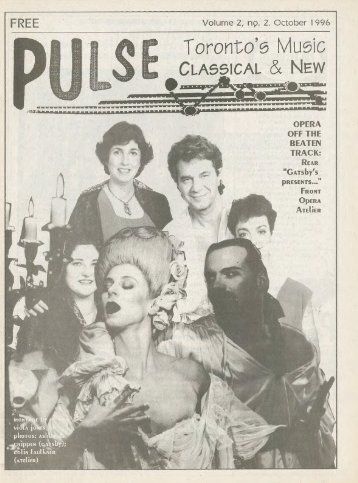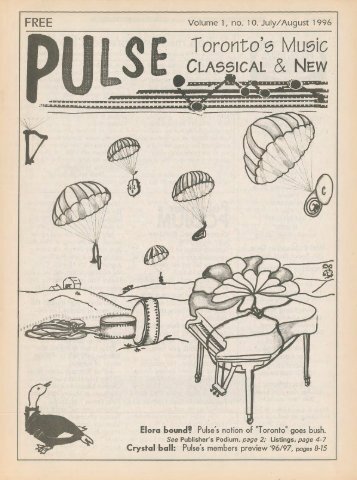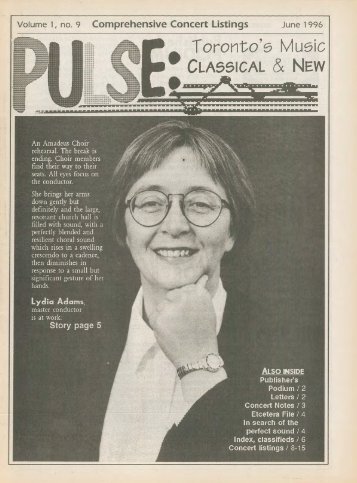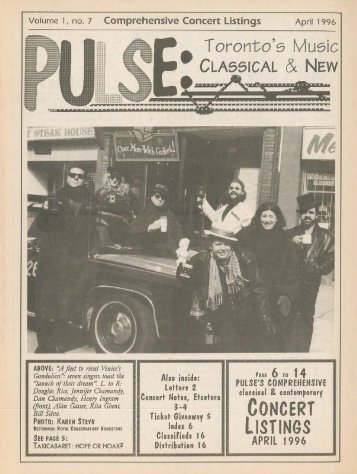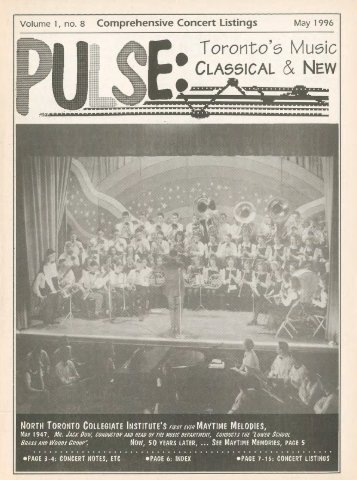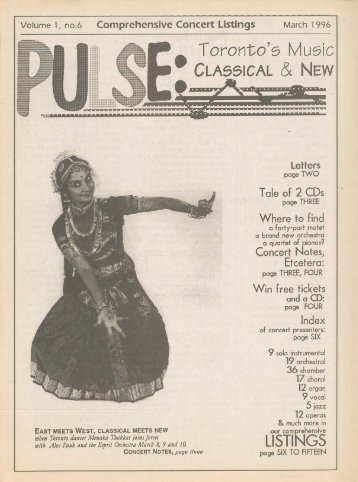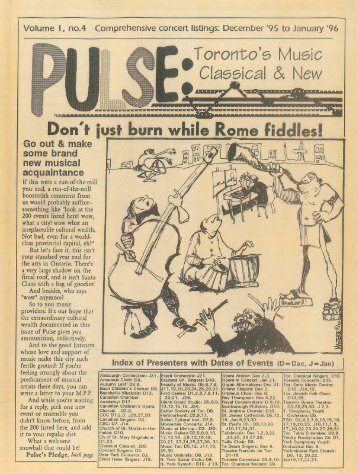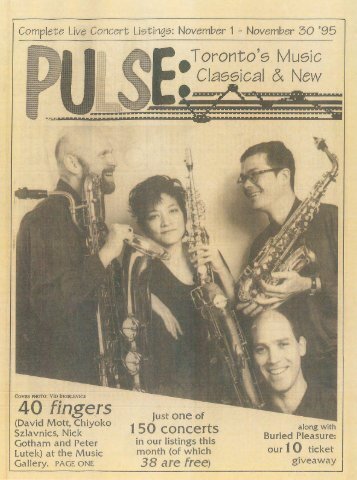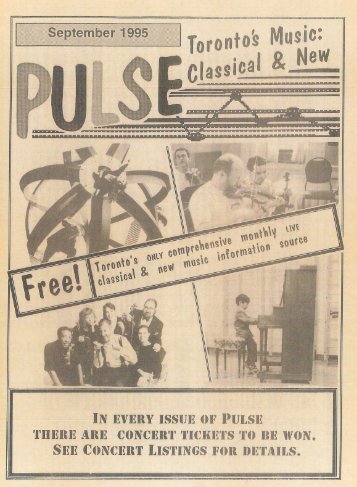Volume 28 Issue 4 | February - March 2023
- Text
- Thewholenotecom
- Musical
- Violin
- Arts
- Conductor
- Jazz
- Theatre
- Symphony
- February
- Orchestra
- Toronto
Volume 28 no.4, covering Feb, March and into early April '23! David Olds remembers composer John Beckwith; Andrew Timar reflects on the life and times of artistic polymath Michael Snow; Mezzo Emily Fons, in town for Figaro, on trouser roles, the life of a mezzo-soprano on the road and more; Colin Story on the Soft-Seat beat; tracks from 22 new recordings added to our Listening Room. All this and more.
internationally renowned
internationally renowned Israeli violist Rivka Golani who made her home in Toronto for some years. Favour for viola and live digital delay controlled by the performer was composed in 1980. Sarabande was composed to address the issue of the complicated set-up required for the live electronics aspect of Favour, here replaced by a single playback track for the performer to play against. Favour was originally released on Golani’s Viola Nouveau (Centrediscs CMCCD 0883), still available from the Canadian Music Centre, providing a rare opportunity to compare two interpretations of a contemporary Canadian piece. By pairing these two works we are presented with Jaeger’s “second take” on the same material and also a second performer’s take on them both. It’s great to see a new generation of musicians taking up the mantle and championing existing works along with the new. Mid-career American super-star composer Missy Mazzoli "inhabits an exquisite and mysterious sound-world that melds indierock sensibilities with classical traditions… [equally at home in] concert halls, opera houses and rock clubs." Dark with Excessive Bright (BIS-2572 missymazzoli. com) is a portrait disc spanning 15 years of Mazzoli’s international career, featuring Norwegian violinist Peter Herresthal. Once again, we are presented with a composer’s alternate takes on several works. The title piece was originally a concerto for double bass and string orchestra that at Herresthal’s request Mazzoli reworked for violin, “essentially flipping the work upside down.” Dark with excessive bright is a phrase from Milton’s Paradise Lost, a surreal and evocative description of God’s robes, written by a blind man. Mazzoli says: “I love the impossibility of this phrase and how perfectly it describes the ghostly, heartrending sound of strings.” It appears here twice, bookending the disc, opening with the Bergen Philharmonic Orchestra conducted by James Gaffigan and closing with a reduced version for solo violin, string quartet and double bass performed by members of Norway’s Arctic Philharmonic under the direction of Tim Weiss. Both versions are extremely powerful, with a sound palette that belies the all-string instrumentation, and it’s hard to comprehend that in the latter all that sound is being created by just six players. Vespers for Violin is a reimagining of the earlier Vespers for a New Dark Age, in which “sampled keyboards, vintage organs, voices and strings from that composition, drenched in delay and distortion,” are used to create an effective work for a solo violinist. Full orchestral resources are utilized in Sinfonia (for Orbiting Spheres) with music “in the shape of a solar system.” The title draws on two meanings of the word sinfonia: a Baroque work for chamber orchestra and the old Italian term for a hurdy-gurdy. Mazzoli describes it as “a piece that churns and roils, that inches close to the listener only to leap away at breakneck speed, in the process transforming the ensemble into a makeshift hurdygurdy, flung recklessly into space.” There’s a Toronto connection in Orpheus Undone. It’s an orchestral suite, fragments of which have their origins in Orpheus Alive, a work composed for the National Ballet of Canada back in 2019. In its present form, it depicts “a single instant in Orpheus’s life, in the immediate aftermath of his wife Eurydice’s death. I have used the Orpheus myth… to explore the ways traumatic events disrupt the linearity and unity of our experience of time.” It was composed in 2021, no doubt in response to the trauma of COVID-19. Concert Note: Speaking of Toronto, Mazzoli’s Dark with Excessive Bright will be performed in its original double bass version by the Toronto Symphony and guest conductor Kerem Hasan, with TSO principal Jeffrey Beecher as soloist on March 1 and 2 at Roy Thomson Hall. We invite submissions. CDs, DVDs and comments should be sent to: DISCoveries, WholeNote Media Inc., The Centre for Social Innovation, 503 – 720 Bathurst St. Toronto ON M5S 2R4. David Olds, DISCoveries Editor discoveries@thewholenote.com STRINGS ATTACHED TERRY ROBBINS Vagues et ombres (Waves and shadows), the latest release from the Montreal string ensemble Collectif9 features music by Debussy and Canadian-American composer Luna Pearl Woolf (Alpha Classics 858 collectif9.ca/en). The central work on the disc is Woolf’s Contact, an extremely effective and fascinating piece described as “a sonic view into the underwater world of beluga whales in the St. Lawrence Estuary,” including the impact of human actions. It’s the Debussy selections that steal the show, however, in quite brilliant arrangements by Thibault Bertin-Maghit, the group’s bass player. Four piano pieces – Étude No.4, Des pas sur la neige, and Passepied and Clair de lune from the Suite Bergamasque open the CD, the increase in players and the resulting expansion of textures being balanced by the challenge faced in reducing Debussy’s orchestral masterpiece La Mer to nine players. The latter is an astonishing reinterpretation that draws quite remarkable playing from the ensemble in music in which – as they note – timbre and colour are paramount. It’s breathtakingly brilliant in all respects. Baroque violinist Gottfried von der Goltz is the soloist on Mozart Violin Concertos Nos.3-5 with the Freiburger Barockorchester under Kristian Bezuidenhout (Aparté AP299 prestomusic. com/classical/products/9364986--mozartviolin-concertos-nos-3-5). The three concertos – the G Major K216, the D Major K218 and the A Major K219 – are “presented in a new version: in accordance with practices of the time, Bezuidenhout improvises a pianoforte part, while conducting the orchestra… A totally new and exciting approach to these works!” Well, don’t get too excited about the resulting impact – the pianoforte is almost totally inaudible, although it may well be subtly adding to the texture; if I hadn’t known I would never have noticed it, except possibly in a few moments in the D Major concerto. No matter, for these are superb performances any way you look at them, beautifully judged and balanced, with faultless solo work and orchestral playing that is full of life on one of the finest Mozart discs you will hear. The brilliant Norwegian violinist Vilde Frang is in top form on Beethoven Stravinsky Violin Concertos, with The Deutsche Kammerphilharmonie Bremen under Pekka Kuusisto (Warner Classics 0190296676437 vildefrang.com/ beethoven-stravinsky). Kuusisto, himself a violinist makes his debut recording as a conductor, and what a debut it is, forming a perfect partnership with Frang. There’s a decided chamber orchestra feel to the performance with the timpani 48 | February & March, 2023 thewholenote.com
prominent, the lengthy first movement cadenza being a transcription of the one (with timpani) that Beethoven wrote for his own piano transcription of the concerto. Stravinsky’s spiky and neoclassical Violin Concerto in D Major Op.8 isn’t heard as often as it should be, the performance here underlining what we’re missing. It’s full of life and never merely academic, with an emotionally deep Aria II third movement. Frang started studying both concertos at the same time in her teens, always feeling some sort of relation between the two. Certainly they make an ideal pairing on an outstanding CD. With Schumann: The Three Violin Sonatas violinist Andrew Wan and pianist Charles Richard-Hamelin continue the partnership that gave us the recent outstanding 3CD set of the complete Beethoven sonatas (Analekta AN 2 9003 analekta.com/en). The Violin Sonatas No.1 in A Minor Op.105 and No.2 in D Minor Op.121 are from 1851, written at the suggestion of violinist Ferdinand David. The Violin Sonata No.3 in A Minor WoO27 incorporates the two movements Schumann contributed to the F-A-E sonata, the 1853 collaboration with Brahms and Albert Dietrich that was a gift for Joseph Joachim, Schumann adding a first movement and a scherzo to complete an original third sonata. Effortlessly beautiful playing from both performers coupled with exemplary recording quality makes for another outstanding release. Concert note: Mooredale Concerts presents Andrew Wan and Charles Richard-Hamelin in works by Schumann, Medtner and Franck, Sunday February 12, at Walter Hall. From one outstanding duo release to another: Shostakovich Rachmaninoff Sonatas for Cello & Piano finds cellist Carmine Miranda and pianist Robert Marler in superb form in two of the great cello sonatas (Navona NV6475 navonarecords. com/catalog/nv6475). Miranda’s deep, rich cello and Marler’s clear, warm piano, perfectly balanced and beautifully recorded, immediately promise great things – and boy, do they deliver! Shostakovich’s Cello Sonata in D Minor Op.40 from 1934 is described as a lyrical, classical work, but it still has the painridden slow movement and frantic fast movements so typical of his later works. The Rachmaninoff Cello Sonata in G Minor Op.19 from 1901 is a big Romantic work that requires a big technique from both players, its third movement Andante surely one of the most glorious movements ever written. It’s hard to imagine a more gorgeous performance than this one. Violinist Patricia Kopatchinskaja and pianist Fazil Say have been playing together as a duo since 2004, and the close nature of their musical relationship is clearly evident in the three sonatas on Janáček Brahms Bartók (Alpha Classics ALPHA885 outheremusic.com/en/classical-music-shop/ latest-releases). The Janáček and Bartók sonatas were both completed in 1921, and both show the influence of folk music on the two composers. The Brahms work is the last of his three, the Sonata No.3 in D Minor, Op.108, completed in 1888. Kopatchinskaja has a clear, bright tone that can sound quite light at times without ever losing strength, and the ease with which she handles the technical demands never lacks depth and conviction. Say is an equal partner in all respects on an excellent disc. Xuefei Yang was the first Chinese guitarist to study at London’s Royal Academy of Music, and the first to launch a worldwide professional career. Guitar Favourites, her latest CD, reviews her 35 years with the guitar, returning to the quintessential guitar music that first drew her under its spell (Decca 485 8195 xuefeiyang.com). Her technique is flawless and apparently effortless, but it’s what she does with it that makes this such a remarkable disc; the clarity, definition, dynamics and flowing, flexible phrasing making even the most familiar pieces sound fresh. Works include Albéniz’s Asturias, Tárrega’s Recuerdos de la Alhambra (with rubato!) and Capricho Árabe, Sor’s Variations on a Theme by Mozart Op.9, four pieces by Augustín Barrios Mangoré including the three-part La Catedral, Yang’s own Xinjiang Fantasy, the first recording of When the Birds Return by guitarist John Williams and single pieces by Rodrigo, Lauro and Villa-Lobos. A gorgeous arrangement of Danny Boy completes a stunning recital. A composition by the British pianist Stephen Hough opens Hough, Dutilleux & Ravel String Quartets, the latest CD from the Takács Quartet (Hyperion CDA68400 hyperion-records.co.uk/ dc.asp?dc=D_CDA68400). Hough’s six-part String Quartet No.1, “Les Six rencontres” was written in 2021 specifically as a companion piece to the Dutilleux and Ravel works. It’s extremely attractive, finely crafted and idiomatic writing, dedicated to the Takács Quartet and given what must be a definitive performance here. Henri Dutilleux’s Ainsi la nuit from 1973-76 began as a group of short studies in sonority, the seven linked sections creating fascinating effects and tonal colours. Again, there’s superbly controlled and nuanced playing from the quartet. A dazzling reading of Ravel’s String Quartet in F Major from 1902-03 completes a terrific CD. 2022 saw the Tippett Quartet mark their 25th anniversary year and the 150th anniversary of Vaughan Williams’ birth with Ralph Vaughan Williams & Gustav Holst String Quartets (SOMM Recordings SOMMCD 0656 somm-recordings.com/recording/ vaughan-williams-holst-string-quartets). Vaughan Williams spent the year 1907-08 Rosebud String Quartet’s new album, Haydn Op. 77 & Mozart K. 614, is out now! Bringing together three great works by masters of Viennese classicism, Mozart and Haydn, the Rosebud String Quartet’s remarkable chemistry and depth bring these compositions to life. Haydn Op. 77 & Mozart K. 614 is available on all major streaming platforms! www.leaf-music.ca www.rosebudquartet.com thewholenote.com February & March, 2023 | 49
- Page 1 and 2: VOLUME 28 NO 4 FEBRUARY - MARCH 202
- Page 5 and 6: 2804_FebMar_cover.indd 1 2023-02-03
- Page 7 and 8: KOERNER HALL 2022.23 Concert Season
- Page 9 and 10: Collaborative life on the choral sc
- Page 11 and 12: KOERNER HALL 2022.23 Concert Season
- Page 13 and 14: Drumming@50, Interview 3. Clockwise
- Page 15 and 16: support of a deep sense of musicali
- Page 17 and 18: illiantly with the strictly classic
- Page 19 and 20: THURSDAY NOON AT MET WEEKLY FREE CO
- Page 21 and 22: KOERNER HALL 2022.23 Concert Season
- Page 23 and 24: work of Vivaldi himself - unlike hi
- Page 25 and 26: QUICK PICKS FEB 12, 2PM: Don Wright
- Page 27 and 28: The high-risk soloist’s life I as
- Page 29 and 30: Meet Mr. Snow Those who met Michael
- Page 31 and 32: At Jazz Bistro, impress your date w
- Page 33 and 34: Vinettes. Paul Davenport Theatre, T
- Page 35 and 36: The Art of the Piano BRUCE VOGT Feb
- Page 37 and 38: Orchestral Suite No.1 in C BWV1066;
- Page 39 and 40: 2022-2023 Season: A Golden Annivers
- Page 41 and 42: ● 3:00: Scarborough Philharmonic
- Page 43 and 44: ● 3:00: West Plains United Church
- Page 45 and 46: theWholeNote.com There’s a wealth
- Page 47: Bassist Robert Alan Mackie reappear
- Page 51 and 52: Igor Yuzefovich. The Largo in F Maj
- Page 53 and 54: eager to make love and urge Siegfri
- Page 55 and 56: Lost in Venice Infirmi d’Amore; V
- Page 57 and 58: lumberish. Cellist Benjamin Wensel
- Page 59 and 60: ILTA Stefanie Abderhalden; Kyle Fle
- Page 61 and 62: Poul Ruders - Clarinet Quintet; Thr
- Page 63 and 64: alance the horizontal flow. This is
- Page 65 and 66: with. This is not an uncommon feeli
- Page 67 and 68: a lot. There are moments where each
- Page 69 and 70: More attuned to expected improvisat
- Page 71: in Royal Festival Hall in 1958. As
Inappropriate
Loading...
Mail this publication
Loading...
Embed
Loading...

